Marine Corps News

Biden says uncle’s remains never found during WWII due to cannibals
While the claim contradicts the DPAA report about his uncle's fate, Biden's comments on cannibalism in the region during WWII are not far off.
On Wednesday, President Joe Biden suggested not once, but twice that the remains of his uncle, Second Lt. Ambrose Finnegan, were unable to be recovered “because there used to be a lot of cannibals” in the southwestern Pacific.
Serving in the U.S. Army Air Force during the Second World War, Finnegan was a passenger of an A-20 Havoc, when, for “unknown reasons, this plane was forced to ditch in the ocean off the north coast of New Guinea,” according to an account published by the Defense POW/MIA Accounting agency. “Both engines failed at low altitude, and the aircraft’s nose hit the water hard.”
“And my uncle, they called him — Ambrose, they called him Bosie… and he became an Army Air Corps, before the Air Force came along, he flew those single engine planes as reconnaissance over war zones,” Biden said during remarks at the United Steelworkers Headquarters in Pittsburgh.
“And he got shot down in New Guinea, and they never found the body because there used to be a lot of cannibals — for real — in that part of the New Guinea.”
Biden’s claim contradicts the DPAA report, which notes that “Three men failed to emerge from the sinking wreck and were lost in the crash. One crew member survived and was rescued by a passing barge.”
The president’s comments on cannibalism, meanwhile, are not far off. In 1992, nearly half a century after World War II, Japanese historian Toshiyuki Tanaka revealed that he had uncovered more than 100 cases of cannibalism committed by Japanese troops in Papua New Guinea.
“These documents clearly show that this cannibalism was done by a whole group of Japanese soldiers, and in some cases they were not even starving,” Tanaka said.
A translated Imperial Army order from Nov. 18, 1944, described cannibalism as the “worst human crime” and blamed increases in murders and the possession of human flesh by soldiers on a “lack of thoroughness in moral training,” according to the Associated Press.
“In all cases, the condition of the remains were such that there can be no doubt that the bodies had been dismembered and portions of flesh cooked,” one Australian lieutenant recalled after finding the dismembered remains of several comrades.
The military was ultimately unable to recover the remains of the president’s uncle, whose life and service are memorialized on the Walls of the Missing at the Manila American Cemetery in the Philippines.
“President Biden is proud of his uncle’s service in uniform, who lost his life when the military aircraft he was on crashed in the Pacific after taking off near New Guinea,” White House deputy press secretary Andrew Bates told CNN.
“The president highlighted his uncle’s story as he made the case for honoring our ‘sacred commitment … to equip those we send to war and take care of them and their families when they come home,’ and as he reiterated that the last thing American veterans are is ‘suckers’ or ‘losers.’”

A child thought he’d found a rock — it was actually a Marine’s jawbone
A human jawbone discovered in the Arizona desert was recently discovered to belong to a U.S. Marine Corps captain.
A human jawbone discovered in the Arizona desert was recently identified as remains of U.S. Marine Corps Capt. Everett Leland Yager.
The issue? No one knew it was missing.
The 30-year-old World War II veteran was killed in July 1951 during a military training exercise over the skies of Riverside County, California. His remains were returned to his family and he was buried in his home state of Missouri.
Decades passed until a child, looking to build upon his rock collection, came across the unusual “stone” while scavenging in Yavapai County, Arizona.
Pocketed and taken home, the remains of Yager were swiftly turned over to the Yavapai County Sheriff’s Office where it became known as “Rock Collection John Doe” until January 2023.
That’s when, according to a press release from Rampo College of New Jersey, the “Yavapai County Medical Examiner referred the case to the Ramapo College of New Jersey Investigative Genetic Genealogy (IGG) Center.”
With the assistance of the University of North Texas Center for Human Identification and Intermountain Forensics in Salt Lake City, a profile was developed last May and “uploaded to a portal supporting police and forensic teams with investigative comparisons, and FamilyTreeDNA, a Houston-based genetic testing company,” according to the Arizona news outlet AZ Family.
The researchers identified Yager as the most likely candidate for Rock Collection John Doe, and last month a sample taken from Yager’s daughter confirmed that the jawbone did in fact belong to her long-deceased father.
As to how Yager’s remains came to rest in Arizona? The team of investigators theorize that a scavenger bird picked up the bone sometime after the crash and carried it east.
Now, 73 years after his death, plans are being arranged to return Yager’s full remains to his family.

Pentagon presses Congress for Ukraine funding, citing dire situation
Pentagon leaders told Congress that Ukraine and Israel both desperately need weapons being held up by a failure to pass a funding package.
Ukraine and Israel both desperately need the military weapons that are being held up by Congress’ failure to pass a funding package for the two countries at war, Pentagon leaders told House appropriators Wednesday, calling the situation in Ukraine dire.
“Whether it’s munitions, whether it’s vehicles, whether it’s platforms,” Ukraine is being outmatched by the Russians, Gen. CQ Brown, chairman of the Joint Chiefs of Staff, told the House Defense Appropriations Subcommittee. “I’ll just tell you that Ukraine right now is facing some dire battlefield conditions.”
Defense Secretary Lloyd Austin, seated alongside Brown, told lawmakers that time matters.
“We’re already seeing things on the battlefield begin to shift a bit in Russia’s favor. We are seeing them make incremental gains. We’re seeing the Ukrainians be challenged in terms of holding the line,” he said.
Their grim assessments came as House Republicans wrangle over the $95 billion foreign aid bill that the Senate passed in February. That legislation provides funding for Ukraine, Israel and other allies, as well as humanitarian aid for civilians in Gaza and Ukraine and replenishment cash for the U.S. military to replace weapons sent to Ukraine.
House Speaker Mike Johnson was forging ahead Wednesday toward votes later this week on the funding, even as he risks losing his leadership post in the bitterly divided Republican caucus.
President Joe Biden urged Congress to pass the aid, saying that besides critical support to Israel and Ukraine, it would offer “desperately needed humanitarian aid to Palestinians in Gaza.” He said he would sign the funding package right away, sending a message that “we won’t let Iran or Russia succeed.”
Members of the House panel lamented the gridlock that has stalled the foreign aid, but several said they are hopeful the legislation will begin to move.
Rep. Betty McCollum, D-Minn., noted the “chilling” comments by Gen. Christopher Cavoli, the top U.S. military commander for Europe last week. He told the committee that Ukraine will be outgunned 10 to one by Russia within a matter of weeks if Congress doesn’t approve the funding.
“Without the United States assistance, Ukraine will literally run out of ammunition and more civilians in Ukraine will be murdered by Russia,” McCollum said.
Brown told lawmakers that Israel also critically needs support in the bill, including air defense interceptors and munitions to defend itself following Iran’s attack over the weekend. Iran launched about 300 missiles and drones toward Israel on Saturday, but the vast majority were shot down by Israeli defenses or U.S. and other allies. The attack came less than two weeks after a suspected Israeli strike in Syria killed two Iranian generals in an Iranian consular building.
Israel has vowed to retaliate as the U.S. and other allies urge restraint.
The funding issue dominated the hearing, including its impact on the U.S. military and defense companies scattered across 30 states. The Pentagon’s comptroller, Michael McCord, said the Defense Department has already spent about $2 billion for military operations in Europe and the Middle East to ensure troops and allies there are secure.
Some of that includes the movement of Navy ships to help protect Israel over the weekend and the extended deployment of ships in the Red Sea and Gulf of Aden to safeguard commercial and military vessels being targeted by Iran-backed Houthis in Yemen.
Without the supplemental funding, McCord said the $2 billion would have to be absorbed by the base budget and shifted from other spending on things like facilities and equipment maintenance.
“So there is an impact on our forces and our readiness as well if we cannot get the supplemental approved,” he said.
Austin also repeated a selling point that defense leaders have been making to lawmakers over the past several months: The funding bill will directly help the American defense industry that is building Abrams tanks, ammunition and other weapons and equipment.
He said about $50 billion in the supplemental will flow through the defense industrial base “creating good American jobs in more than 30 states.”
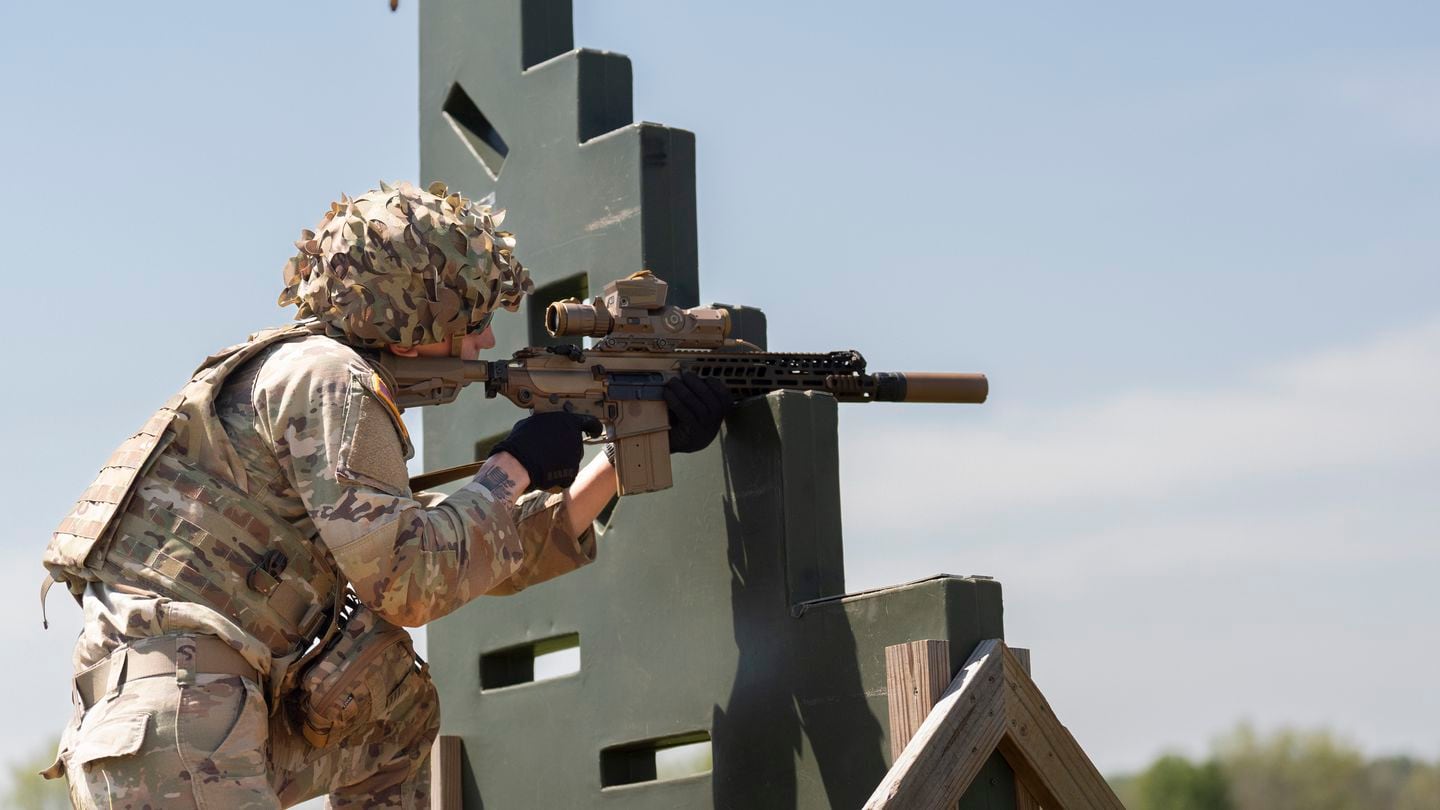
Next Generation Squad Weapon and optic exceed soldiers’ expectations
The brigade will be fully fielded with the new weapons by September.
The first soldiers to field the Army’s newest rifle and automatic rifle began live-fire training with the weapons this week, including demonstrations on how the new round can penetrate barriers to strike targets.
Soldiers with the 1st Brigade, 506th Infantry Regiment, 101st Airborne Division received a batch of XM7 rifles and XM250 automatic rifles and their XM157 fire controls in late March.
The XM7 is the Army’s replacement for the M4 while the XM250 will replace the M249 Squad Automatic Weapon. Both new weapons are chambered in 6.8mm, a larger and more powerful round than the legacy 5.56mm round used in the M4 and M249.
The soldiers conducted classroom training last week and began firing the weapons in demonstrations on Monday, Col. Trevor Voelkel, 1st Brigade commander, told Army Times in a phone interview.
Voelkel said he was impressed with the demonstration that showed the 6.8mm round piercing concrete blocks to strike paper targets on steel backdrops behind the barriers.
101st Airborne first Army unit to field Next Generation Squad Weapons
“Seeing the effects on the targets we had makes up for any concerns I had initially about the increased weight,” the colonel said.
Unloaded, the XM7 weighs 8.4 pounds, which is 3 pounds heavier than the M4. The XM250 weighs roughly 13 pounds unloaded, which is 2.7 pounds lighter than the M249.
The 6.8mm round has a lethal range of at least 600m, twice that of 5.56mm rounds, Army officials said.
Staff Sgt. Garrett Steele, a weapons squad leader, and Sgt. Marcus Colston, bravo team leader, told Army Times that before they fired the weapon they were worried that the new round would add recoil, which might make it hard to get back on target.
“The recoil, honestly, was very negligible even with the larger round,” Colston said. “The weight of the weapon was pretty negligible.”
Steele agreed and said the XM7 was very accurate, both with iron sights and the new fire control. The weapons team leader said the group of soldiers with 1st Brigade that he trained with were able to zero their weapons and get tight groupings after shooting 10 rounds or fewer.
“There wasn’t anybody who had any issues getting groupings or zeroing quickly,” Steele said.
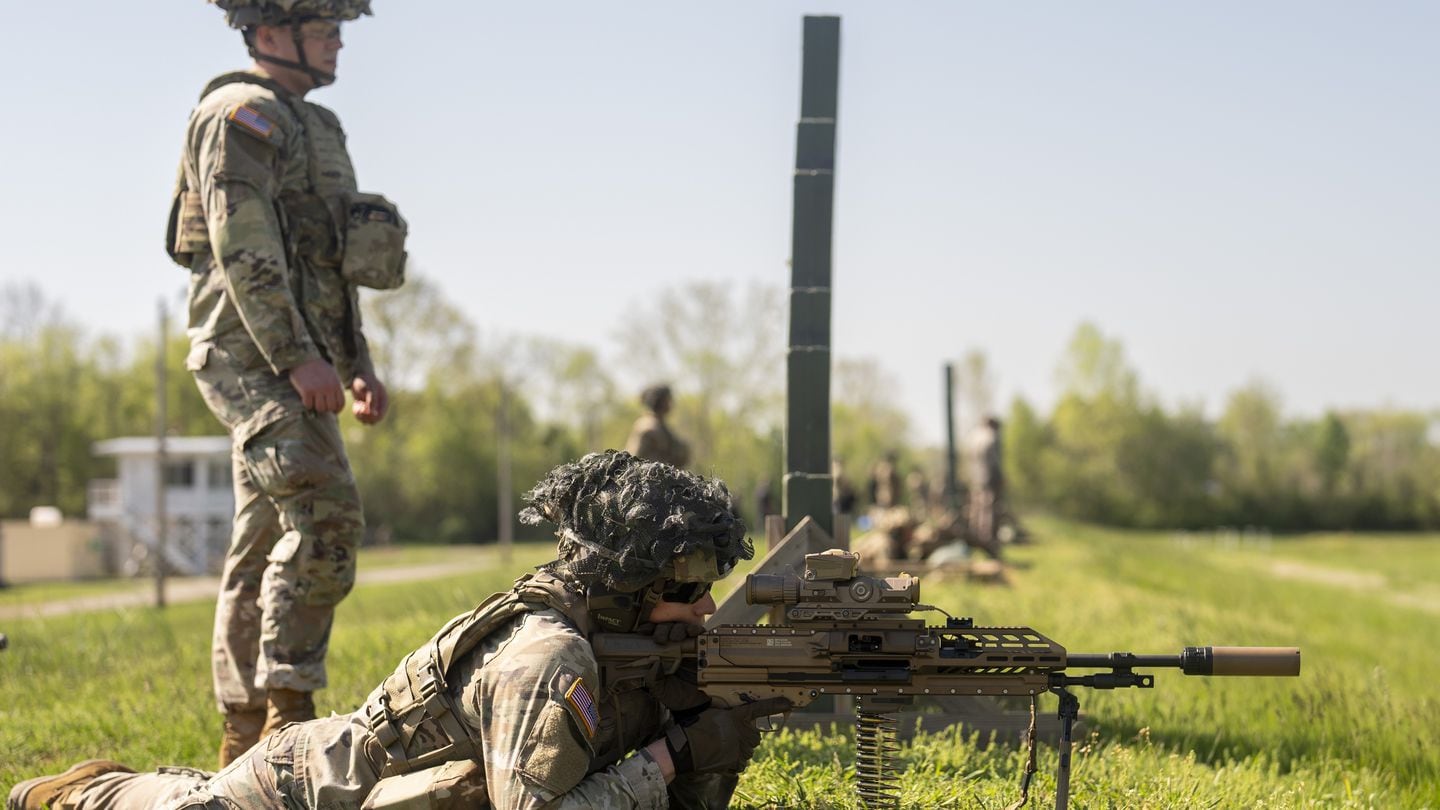
The XM157 has a host of features not available in the standard rifle optics such as the Close Combat Optic and Advanced Combat Optical Gunsight that have been used by soldiers for years.
The new fire control has a built-in infrared aiming laser, bullet drop compensator and ballistics calculator that can receive data for any weapons system in the Army’s inventory and add new data for future weapons.
The fire control will adjust the aiming point for the shooter based on distance and the ballistics of the round. It allows shooters to use eight times magnification to zoom in on a target, compared to the four times magnification on current standard optics.
Both sergeants said the optic was easy and quick to use. And the features were all applicable.
“There’s no fluff on the optic,” Colston said. “Everything that we can do with that, in my experience, the things we do as infantrymen, every single one of those features is going to be useful at a certain time.”
Voelkel echoed his soldiers’ comments on the fire control, comparing it to the current optics.
“It’s kind of like going from my Nokia flip phone to an iPhone,” he said.
The rangefinder and IR laser will allow soldiers to mark target reference points and laser targets for call for fire in the field with no additional equipment, the colonel said.
“I think that’s going to open up a whole new world of capabilities,” Voelkel said.
The brigade will receive 1,500 XM7s and 200 XM150s, all with their own optics, according to Program Executive Office-Soldier. The brigade is expected to be fully fielded with the new weapons by September.
The brigade is scheduled for their pre-deployment Joint Readiness Training Center rotation in March 2025, Voelkel said. The unit has a large-scale field training exercise scheduled for this fall with the entire 101st Airborne Division.
Those events will help the unit see the performance of a brigade fully equipped with the new small arms and optics in both live fires and simulated, force-on-force training, the colonel said.
During force-on-force exercises, soldiers armed with the weapons will have greater ranges and the ability to penetrate barriers when in a close fight. The laser shooting systems used for force-on-force can be adjusted to accommodate the 6.8mm ballistics so commanders can get a sample of its performance.
“It’s going to allow us to engage the enemy earlier than we would have,” Garrett said. “If we see an enemy far out, we can get better eyes on with the optic.”
In 2017, the 101st Airborne Division was also the first unit to field the replacement for the legacy M9 handgun with the Modular Handgun System, which includes the M17 and M18 handguns.
Following that fielding with the next generation weapons gives the division a chance to give the Army feedback on a weapon that many soldiers may carry for decades to come.
“I think there’s a lot of pride and a feeling of weighty responsibility,” Voelkel said.
The $4.7 billion rifle and automatic rifle weapons contract with firearms manufacturer Sig Sauer and the $2.7 billion contract with Sheltered Wings, a subsidiary of Vortex Optics, for the XM157, are the most significant changes to Army individual weapons since the M16 was fielded in the 1960s.
The XM7 is a piston-driven, modular, select-fire, magazine-fed, suppressed rifle.
The XM250 is a belt-fed, air-cooled, lightweight, gas-operated, select-fire, suppressed light machine gun that fires from the open-bolt position.
The Army plans to field the new weapons to close combat forces such as infantry, special operations, scouts, combat engineers, forward observers and combat medics by fiscal year 2033.
The legacy M4 and M249 will see continued use for decades to come for the rest of the Army.
Correction: This article has been updated to remove an inaccurate reference to a 7.62mm comparison with 6.8mm.

Ex-Army financial adviser pleads guilty to scamming Gold Star families
A former Army financial adviser admitted to taking advantage of his role to swindle deceased troops’ grieving loved ones out of millions.
An Army Reserve major pleaded guilty to using his position as an Army financial counselor to defraud Gold Star families, the Department of Justice announced Tuesday.
Caz Craffy, 41, who also goes by “Carz Craffey,” admitted to taking advantage of his role to swindle deceased troops’ grieving loved ones out of millions, according to a release from the U.S. Attorney’s Office for the District of New Jersey.
As a result of his criminal activity, Gold Star families lost more than $3.7 million, while Craffy personally pocketed more than $1.4 million in commissions. The scam prompted a move in Congress to strengthen oversight of the military’s financial counselors.
“Nothing can undo the enormous loss that Gold Star families have suffered, but the Justice Department is committed to doing everything in our power to protect them from further harm,” U.S. Attorney General Merrick B. Garland said in the statement.
Officials charged Craffy last year with 10 counts, including six counts of wire fraud, following an investigation by The Washington Post.
Craffy worked as an Army civilian financial counselor from November 2017 to January 2023, entrusted with providing guidance to the surviving beneficiaries of deceased troops who can be eligible for hundreds of thousands of dollars in compensation. But without telling the Army, Craffy simultaneously maintained outside employment with two separate investment firms.
The vast majority of families whose finances Craffy mishandled mistakenly believed his management of their money was done on behalf of the Army.
Gold Star families invested more than $9.9 million in accounts Craffy managed in his private capacity from May 2018 to November 2022. Once in control of the money, he repeatedly executed trades, often without their authorization, which earned him high commissions.
In a particularly appalling offense, Craffy misappropriated $50,000 from the account of a minor whose parent died on active duty, the U.S. Securities and Exchange Commission previously said in a release.
Craffy began his time in the Army Reserve in 2003, according to a service record previously shared with Military Times.
A plea agreement outlines a prison term of roughly eight to 10 years, though a sentencing scheduled for August will determine how much time he officially receives, as well as how much money he is ordered to pay.
The SEC also has a pending civil complaint against Craffy based on the same and additional conduct, the Justice Department release noted.
“We take these matters very seriously and will address this issue in accordance with Army regulations and the Uniform Code of Military Justice to ensure due process,” Army Reserve spokesperson Lt. Col. Addie Leonhardt told Military Times in a statement. “However, the Privacy Act precludes the Army Reserve from discussing a specific soldier’s case in further detail.”
Craffy’s attorney did not immediately respond to Military Times’ request for comment.

Meet the Marine aviator of the year ― an unmanned aerial vehicle pilot
Maj. Shane Gentry used his real-world experience remotely piloting the MQ-9A in combat missions to train other Marines to fly the aircraft.
On March 14, Marine Maj. Shane Gentry’s phone started lighting up with text messages from friends and colleagues saying, “Congratulations.”
The texts left Gentry scratching his head. Congratulations for what?
Then someone sent him a link to the Marine administrative message that announced him as the Marine Corps Aviation Association’s aviator of the year.
The award came as a surprise to Gentry, 33, who flies the unmanned MQ-9A aircraft. But he said it made him proud to represent a squadron from the Marine Corps’ unmanned aviation community.
“We’re growing in preponderance,” he said, noting that Marines working in unmanned aviation notched other awards from the association this year. “We’re growing in impact.”
Gentry is the first unmanned aerial vehicle pilot to receive the prestigious aviator of the year award since 2016 at the very least, according to the previous announcements available online. Named for Lt. Col. Alfred Cunningham, the Corps’ first aviator, the award is the highest honor specifically for Marine aviators, according to a Marine news release about Gentry’s award.
Already a seasoned pilot of other unmanned aerial vehicles, Gentry used his real-world experience flying the MQ-9A alongside an Air National Guard unit to get the other aviators in the Hawaii-based Marine Unmanned Aerial Vehicle Squadron 3 up to speed on the new aircraft.
“His talent for imparting his impressive knowledge upon the next generation of pilots is unmatched,” Lt. Col. Nicholas Law, the squadron’s commanding officer, said in a statement to Marine Corps Times.
Gentry grew up in Stafford, Virginia, in a family with a legacy of Marine service. Both his father and grandfather had been in the Marine Corps, and he found himself drawn to the excitement and challenge of the service since elementary school, he said.
Gentry received his commission in 2014. After being in a class on unmanned systems as a newly minted officer at The Basic School, he put that field as his No. 1 choice on his job wishlist. He got it.
Gentry started out flying the RQ-7 Shadow and then moved on to the RQ-21A Blackjack.
In July 2021, Gentry began training on the MQ-9A, the large unmanned aerial vehicle that, according to the 2022 Marine aviation plan, the Corps plans to use primarily for surveillance and reconnaissance. The aircraft can lurk in the air for up to 27 hours at a time, according to the Naval Air Systems Command.
The aircraft is fairly new to the Marine Corps, which first leased two of them in 2018 and acquired the pair in 2021, with plans to acquire 16 more.
The newness of the platform means the Marines who operate it often have to puzzle through the problems it poses themselves. That can be frustrating, but it also means young Marines have leeway to take initiative and innovate, according to Gentry.
“There’s really no textbook on how we’re going to do it,” Gentry said.
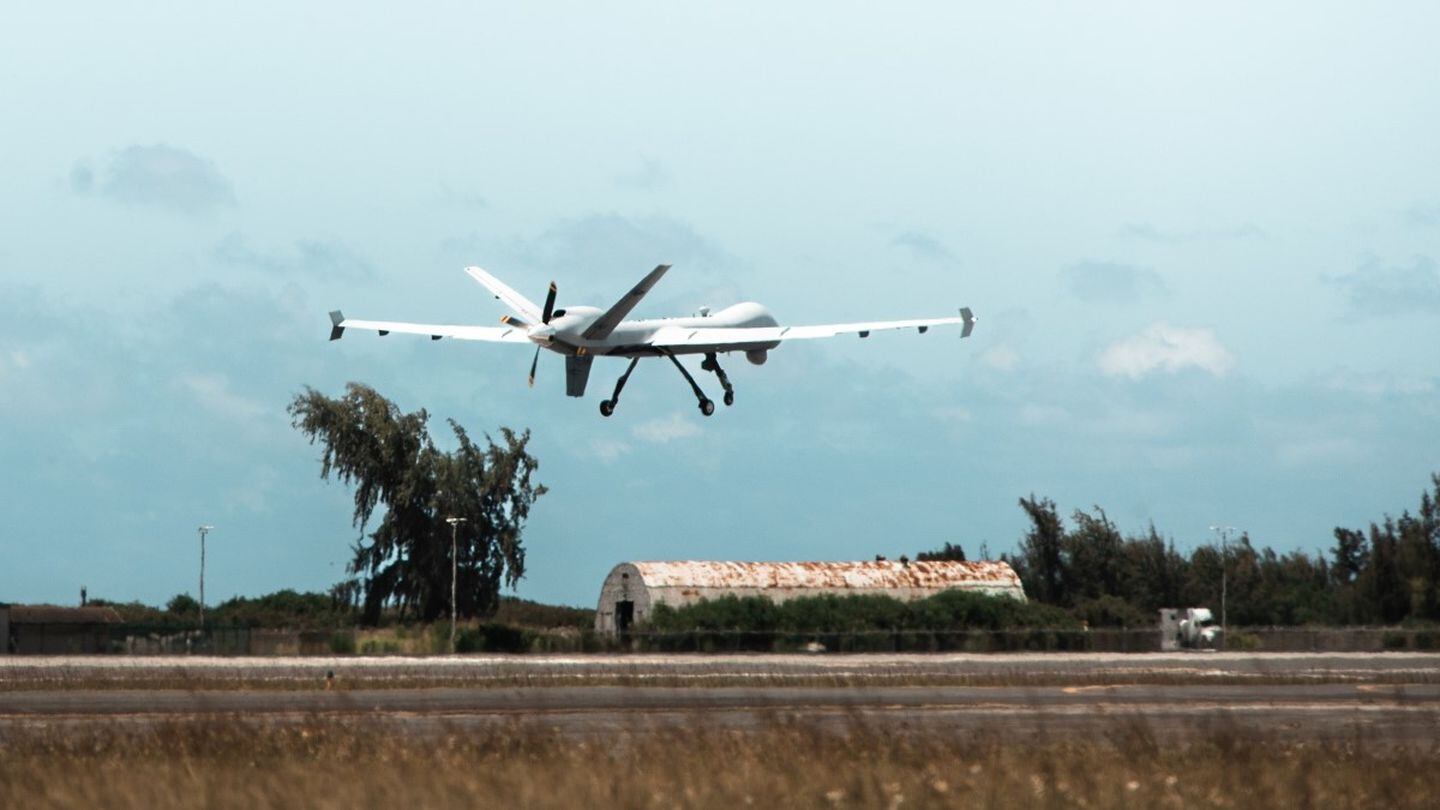
From January 2023 to June 2023, while Marine Unmanned Aerial Vehicle Squadron 3 was receiving its first two of the MQ-9A aircraft, Gentry and three other Marines from the squadron were in Nashville, embedded with the Tennessee Air National Guard.
The Air Force reached initial operating capability with the MQ-9, which it calls the Reaper, in 2007.
Unlike the Air Force’s Reapers, the Marine Corps’ MQ-9A aircraft are not loaded with ordnance for carrying out strikes, Gentry said. The Corps is placing more emphasis on the aircraft’s ability to take in many kinds of data and share that information across large distances, according to Gentry.
While working alongside airmen in Tennessee, Gentry remotely supported “real-world combat operations,” completing 80 sorties and racking up more than 400 hours with the MQ-9A, he said. He discussed those efforts in very general terms to Marine Corps Times, but he noted that he engaged in missions against both larger adversaries and emerging regional threats.
When he returned to Hawaii, Gentry said, he helped squadron leadership develop its practices and training regimens for the MQ-9A. And he instructed Marines himself on aspects of flying the aircraft.
“As one of the most experienced instructors in our ready room, Maj. Gentry has made an outsized contribution to the proficiency of our aircrew,” Law, the squadron’s commanding officer, said.
Yet it wasn’t just Gentry’s mastery of the MQ-9A that made him stand out at Marine Unmanned Aerial Vehicle Squadron 3, Law said. There’s also the fact that he volunteered to stand duty on both Christmas and New Year’s.
“I’m a single officer, so I don’t mind taking holiday duties,” Gentry said.
Plus, he said, the squadron’s hangar, which sits right on Hawaii’s Kaneohe Bay, is a peaceful place from which to watch the fireworks.
Gentry now is the current operations officer at Marine Aircraft Group 24, of which Marine Unmanned Aerial Vehicle Squadron 3 is a part.
He ultimately plans to give the trophy he will receive for the award to that squadron, he said. But first, he will let his parents have it for a bit.
Gentry said his dad, who had heard of the Alfred A. Cunningham Award during his own time in the Corps, was deeply proud — but also surprised — to learn that his son was the recipient.
“He pulled up the MARADMIN himself,” Gentry said.

‘The flak can’t always miss. Somebody’s gotta’ die’
An excerpt from 'I Will Tell No War Stories' by Howard Mansfield.
The German anti-aircraft guns had a hold on the Eighth Air Force. The Eighth issued flak reports that sounded like weather forecasts. Here’s the flak report for September 10, 1944, when my father flew to Ulm in southwest Germany:
Ulm — meager, fairly accurate.
Heilbronn — meager, fairly accurate.
Furth — meager to moderate, inaccurate.
Sindelfingen — moderate to intense, accurate.
And so on through another eighteen cities and towns with reported flak varying from light to heavy, meager to moderate to intense, inaccurate to accurate.
The reported intensity and accuracy of flak varied from man to man in the same crew. There were no standards. How do you measure flak? In some ways the reports may have been a psychological portrait — whoa that was close. When one shell burst right under his plane, a navigator reported, “I thought someone hit me with a baseball bat. The concussion was so terrific.” And a waist gunner, riding through another attack, said, “At 40 degrees below zero, you can sweat.”
Flak hit the big bombers in a rain of steel pellets. It sounded like hail on a tin roof, like BBs rolling around, said the airmen. It could tear into the bomber’s aluminum skin with a “shriek” or a “hissing.” It could splatter the head of your pilot or miss by an inch. Loose, hot steel rattling around, as if your anxieties had taken shape. It was lethal with a randomness that was cruel. They could smell the flak through their oxygen masks.
The German anti-aircraft gunners filled the sky with explosions and steel. Nearly a million men and women were committed to the guns. In the last years of the war, the 88mm guns were grouped in Grossbatterien of twelve, sixteen, eighteen, or twenty-four — a huge shotgun firing thousands of rounds — tons of explosives a minute — four or five miles high. Major targets were surrounded by two hundred guns; oil refineries by 450 guns, and so many guns guarded the factories in the Ruhr Valley that it was known as Flak Alley. The guns had an effect; the Air Force found that flak reduced bombing accuracy by 10 to 20 percent. The big guns rattled the fliers; they were missing their targets.
Each exploding shell launched about 1,500 metal fragments. Some would pass right through the plane, or explode inside, and some shells brought a rain of fire. If they were close enough to see the red center of the dark cloud, they expected to be hit. This could be what hell looks like, thought George McGovern, a B-24 pilot who flew thirty-five missions and was awarded the Distinguished Flying Cross. “Hell can’t be any worse than that.” An unnamed crewman, in another battle, was more direct when he said over the plane’s intercom, “Mary, Mother of God, get me out of this.”
The bombers sometimes returned with hundreds of holes, with engines out or on fire, with ruptured fuel lines and cut rudder cables, with men wounded, maimed, and bleeding to death. On “good missions” with “meager flak” and few of the Luftwaffe’s fighters attacking, bombers and fighters could still be lost or “missing in action.” Seven bombers and four fighters on one mission, nine bombers and three fighters on another “good mission,” as many as ninety-three men “missing.” Telegrams sent to Ada, Oklahoma; Palo Alto, California; Grand Rapids, Michigan; Hillsboro, Texas: “We regret to inform you . . .”
The flak-filled skies followed the bomber crews back to England. When the airmen were flak happy (shaken up), they were sent to flak homes or flak farms on flak leave for a week’s “R & R” (rest and relaxation). At briefings they studied the Flak Zone over a target, looking at the Flak Maps. They carried the word into battle flying B-17s named: Flack Alley, Flack Alley II, Flak Alley Lil’ (2 of those), Flak Alley Lil’ II, Flack Buster, Flak Dancer (2), Flak Dodger (4), Flak Eater, Flak Evader, Flak Fed Gal, Flak Flirter, Flak Fobic, Flak Hack (2), Flak Happy (8), Flak Happy II, Flak Happy Pappy, Flak Heaven, Flak Hopper (2), Flak House (2), Flak Magic, Flak Magnet (2), Flak Magnet II, Flak No. 2, Flak Off Limits, Flak Palace, Flak Plow, Flak Queen, Flak Rabbit, Flak Rat, Flak Rat II, Flack Sack, Flak Sak, Flack Shack (2), Flak Shack (3), Flak Shy, Flak Shy Lady, Flak Suit, Flak-Wolf, Flakstop, Mac’s Flak Shak, Miss Flak, Old Flak Magnet, Ole Flak Sack, Ole Scatter Flak, and so on.
They parodied their fears by singing tunes like As Flak Goes By:
You must remember this
The flak can’t always miss
Somebody’s gotta’ die.
And they carried their fears into their sleep. They had “flak dreams,” said Bud Hutton and Andy Rooney in a wartime book. “You doze off in your sack and pretty soon the F-Ws begin to bore in at you, cannon flashing, and the flak begins to come up in close black puffs; or maybe you find yourself endlessly falling through space, tearing at a parachute which never opens.”
The stories of flak are a literature of near misses, of geometry, chance, and luck. It was a universe in which an inch or two separated life and death or injury.
The Eighth Air Force fed quotes to the press from the pilots and crews of the bombers. The quotes usually said: flak was everywhere, but it missed us. Flak was so thick you could walk on it; the sky was black with flak; we were shot up, but we made it back. Flak grazed my face, my leg, sliced my sleeve and glove to ribbons, but I’m OK. It ripped off my oxygen mask, just missing my Adam’s apple. I can’t figure out how it missed me. It tore a hole in the map I was reading but didn’t touch me.
Kurt Wolf was a tail gunner on a B-17. He was part of the 452nd Bomb Group based just seven miles from the 453rd at Old Buckenham. Wool socks saved his life. He had gotten a pair sent from home. Wool socks were scarce. He was sitting at his gun in the small glass canopy on the tail of the plane when he felt that his right sock had fallen. It had “crawled down in my boot,” he said. At 35 below zero, this could be serious. “I leaned down to pull that sock back up and just as I leaned down . . . a piece of shrapnel took out both those windows where my head was. So that pair of socks saved my life.” That’s how he told the story when he was 87 years old.
The flak stories are like that tale of a fallen sock. The flak was heavy, was accurate, was moderate, light, inaccurate, was everywhere. There was no empty air. The sky was a maze of thick flak smoke. But I’m alive — that was the unstated refrain. And unspoken — for now.
Chance, fate, luck, and near misses live in the vets’ stories — the pilot assigned to the squadron’s “coffin corner” of the formation whose position is switched at the last moment and is saved, the shards of flak twisting through the airplane cockpit missing by an inch or less, the navigator pulled from the English Channel by an RAF rescue launch seconds before he drowned.
Minutes. Inches. Banal changes that meant life or death. Back in the peacetime world — working nine-to-five, taking children to get shoes — how could the veterans explain that they were only in this life by a few inches? It was as though they’d realized, years before the physicists’ theories, that many universes exist side by side — the world with them and the world without them. They saw it and they had no words for it.
The airmen would be woken up at 3:00 a.m. for breakfast — fresh eggs on mission mornings, “combat eggs,” instead of powdered “square eggs.” Some men didn’t eat a thing, and others ate like it was their last meal. “You could hear a pin drop,” a crewman remembered. “You had a 50 percent chance of returning. You don’t want to think about it, but it’s there.”
My father recalled one morning like this. “They woke us at 3:30 in the morning and told us to get on down to the mess hall. A Maximum Effort has been called. That means any airplane that could fly was going to be in the air. So we all got on our bicycles and went over to the mess hall and got on line. And when I got to my turn to tell the cook what I wanted, he said to me, ‘How do you want your eggs? Scrambled or over easy or what?’ The guy behind me says, ‘I think we’re getting killed today because they never ask us how we want our eggs.’ I thought that was funny, at the time anyway.
“On our way over to the mess hall we saw Royal Air Force bombers returning from missions. They returned and flew over our base. The Royal Air Force bombed the enemy at night. We bombed them during the day. How effective this all was has been written about by many people and nobody really knows. I just know it killed a lot of people.”
The pilot and copilot started the four engines about twenty-five minutes before they took off, running through the checklist. This was a “two-man job,” said B-24 pilot Lieutenant Colonel William E. Carigan Jr. “Both pilots are busy with both hands; the copilot with all the mechanical things — sequences of fuel boosters, primers, energizing and meshing starters; the pilot with mixtures and throttles, which require some touch.” After that, the B-24 required “considerable muscle,” said Carigan. It called for “more muscle to fly than does any other airplane.” It was “sternly unforgiving and demanding.”
As they taxied, the bomb bay doors were open to vent fumes. The lead squadron went first. The control tower fired a flare and the big bombers — thirty-five tons at their maximum “war emergency” weight — began moving down the runway toward take-off speed — 160 mph — just seconds apart, closer than at any airport today. “What sounded like a charging bull was actually more akin to a duck beginning to waddle. It was agonizingly slow,” said pilot Eino Alve. “So, you hunched and rocked back and forth in your seat, in a futile attempt to nudge the plane forward faster. Standing behind you and to your right, the engineer watched the engines’ health on the instruments. The co-pilot watched the airspeed indicator, calling out its advancing numbers: 70, 80, 90 . . . and then you were committed. Even if you lost an engine, you’d have no choice but to try to take off.”
“The doors to the bomb bays close behind you, and you know that you are a prisoner of this ship,” said a reluctant reporter for Yank, the Army’s weekly magazine. “That imprisonment can be broken only by three factors, and they are in order: Disaster by explosion and parachuting to another prison, death, or a safe return.”
This was the life my father lived as a teenager — up at 3:30 a.m., breakfast by 4:00, a briefing at the plane to get the target for the day, long hours in flight, the Luftwaffe sometimes attacking, flying through flak over the target, watching the bombs drop, flying home through more flak and possible fighter attacks, landing to be met by the Red Cross girls with sandwiches, doughnuts, and coffee, and then a shot of whiskey at the “interrogation,” the debriefing. And up again to do it the next day.
Excerpted from “I Will Tell No War Stories” by Howard Mansfield. Copyright © 2024 by Howard Mansfield. Excerpted with permission by Lyons Press.

Retired general’s testimony links contractor to Abu Ghraib abuses
An Army general who investigated prisoner abuse at Abu Ghraib has testified that a civilian contractor instructed prison guards to “soften up” detainees.
An Army general who investigated the abuse of prisoners 20 years ago at Iraq’s infamous Abu Ghraib prison testified Tuesday that a civilian contractor instructed prison guards to “soften up” detainees for interrogations.
The retired general, Antonio Taguba, told jurors that the contractor, Steven Stefanowicz, even tried to intimidate the general as he investigated the Abu Ghraib abuses.
“He would lean on the table staring me down. He did not answer questions directly,” Taguba said. “He was trying to intimidate me.”
Taguba’s testimony was the strongest evidence yet that civilian employees of the Virginia-based military contractor CACI played a role in the abuse of Abu Ghraib inmates.
Three former inmates at the prison are suing CACI in federal court in Alexandria, alleging that the company contributed to the tortuous treatment they suffered. The trial, delayed by more than 15 years of legal wrangling, is the first time that Abu Ghraib inmates have been able to bring a civil case in front of a U.S. jury.
The lawsuit alleges that CACI is liable for the three plaintiffs’ mistreatment because the company provided civilian interrogators to the Army who were assigned to Abu Ghraib and conspired with the military police who were serving as prison guards to torture the inmates.
In a report Taguba completed in 2004, he recommended that Stefanowicz be fired, reprimanded and lose his security clearance for “allowing and/or instructing” military police to engage in illegal and abusive tactics.
“He clearly knew his instructions equated to physical abuse,” Taguba’s report concluded.
In testimony Tuesday, Taguba said he personally questioned Stefanowicz for about an hour as part of his investigation.
“He was a very coy type of personality,” Taguba said of Stefanowicz, often referred to as “Big Steve” by Abu Ghraib personnel.
Taguba said his investigation was focused on military police, and his probe of civilian interrogators’ role was limited. But he felt obligated to delve into it, he said, because he received credible testimony from the military police that the civilians were playing an important role in what occurred.
The MPs told Taguba that they weren’t getting clear instructions from within their own military chain of command, and that Stefanowicz and other civilian personnel ended up filling the void. Taguba said the military chain of command was unclear, and that various commanders were not cooperating with each other, all of which contributed to a chaotic atmosphere at the prison.
Taguba said he was several weeks into his investigation before he even understood that civilians were carrying out interrogations at Abu Ghraib. He said he and his staff heard multiple references to CACI but initially misunderstood them, believing that people were saying “khaki” instead.
On cross-examination, Taguba acknowledged the limits of his investigation. A second report, completed by Maj. Gen. George Fay, looked more directly at the role of military intelligence and civilian contractors at Abu Ghraib.
Taguba also acknowledged that his report contained several errors, including misidentifying a CACI employee as an employee of another contractor, and another civilian contractor as a CACI employee.
CACI’s lawyers emphasized that Stefanowicz was never assigned to interrogate any of the three plaintiffs in the case.
As Taguba testified about Stefanowicz, a lawyer asked him if he was indeed intimidated by the CACI contractor.
“Not on your life,” Taguba responded.
The jury also heard Tuesday from one of the three plaintiffs in the case, Asa’ad Hamza Zuba’e, who testified remotely from Iraq through an Arabic interpreter. Zuba’e said he was kept naked, threatened with dogs, and forced to masturbate in front of prison guards.
CACI’s lawyers questioned his claims. Among other things, they questioned how he could have been threatened with dogs when government reports showed dogs had not yet been sent to Iraq at the time he said it happened.
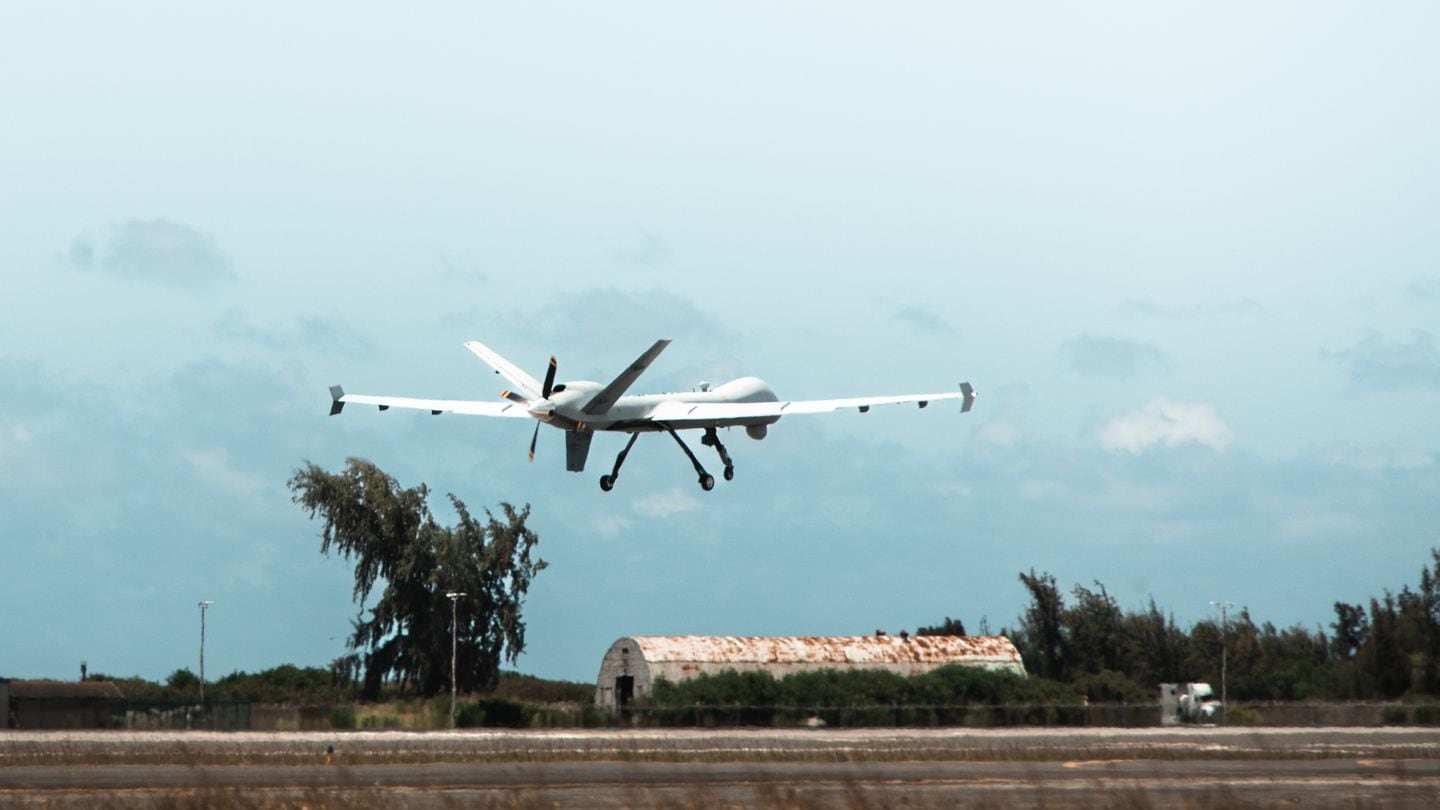
As demand rises, Marines need their own school for MQ-9 drone crews
The Corps has 100 trained MQ-9A pilots but needs more.
As the Marines grow their drone fleet, they need to begin training their own crews instead of relying on the Air Force, the top Marine said.
During budget testimony today before a subcommittee of the Senate Appropriations Committee, Sen. John Hoeven, (R-N.D.), asked Marine Corps Commandant Gen. Eric Smith about the Corps’ needs for airborne intelligence, surveillance and reconnaissance assets.
“The MQ-9 is a vital platform,” Smith said. “We’re focused on the training and procurement of that end.”
The Corps has used the MQ-9A with contractor support since 2018 and began procuring its own MQ-9s and training its pilots through Air Force schools in 2021. As of December, the Corps had 100 MQ-9A trained pilots. The service had two operational MQ-9As as of mid-2023 and plans to field 20 MQ-9s over the next decade.
But as the force grows, the Corps needs its own pipeline to feed the fleet.
“We are currently working with the Air Force to train dually, but we need to stand up the schoolhouse as well, to pull some of that pressure off the Air Force,” Smith said.
This week the Corps announced the assembly of the first MQ-9A at 2nd Marine Aircraft Wing at Cherry Point, North Carolina.
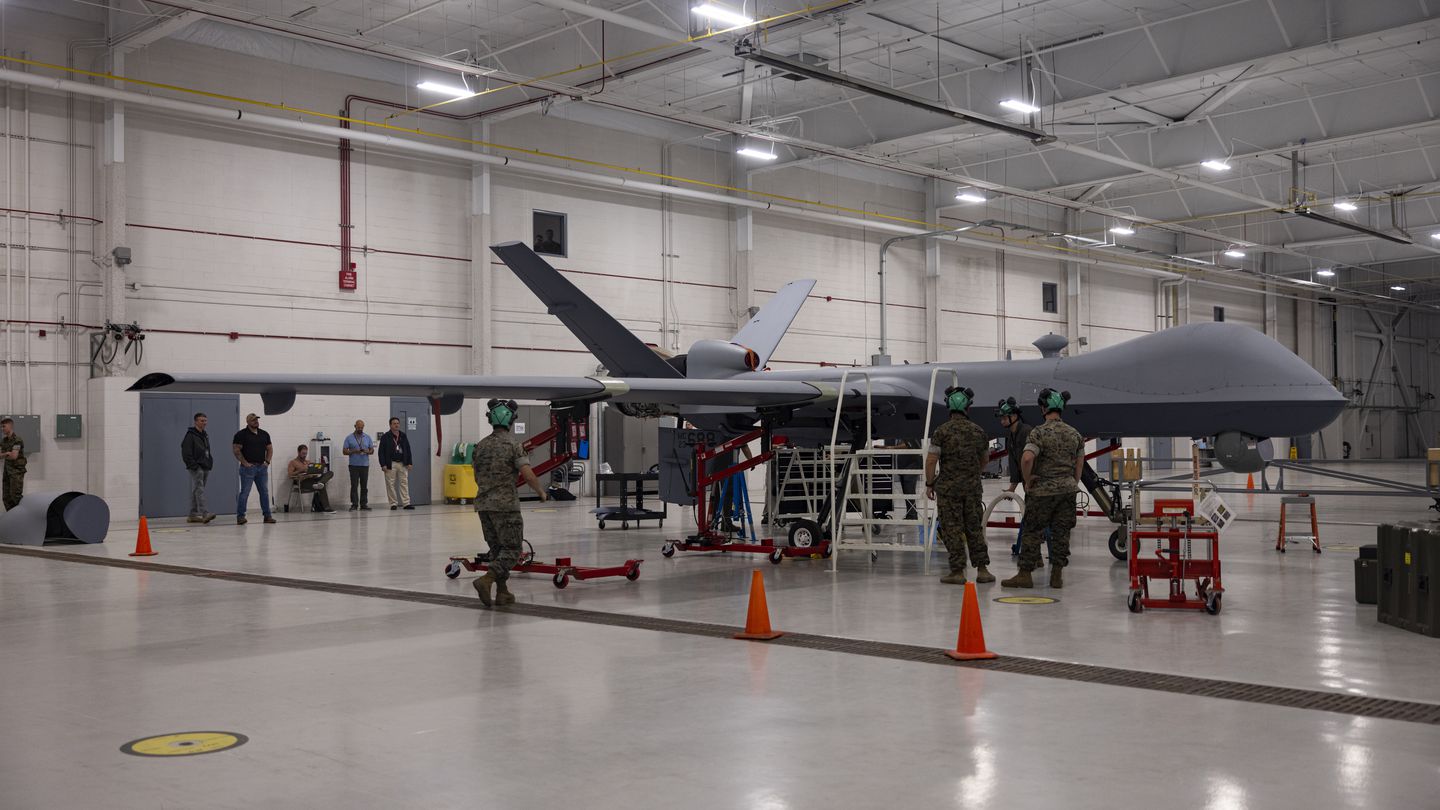
The Marine Corps operates its small drone training certification at the School of Infantry-East, Camp Geiger, North Carolina. The 71-day course teaches Marines to operate the VXE-30 Stalker, the R-80D Sky Raider and the RA-20 Puma, a Marine official said. All of which are group 2 drones, which weigh between 21 and 55 pounds and fly below 2,500 feet.
Marines who earn the small Unmanned Aerial Systems jobe code of 7316 can then train Marines in the fleet, often in infantry units.
The service first established MQ-9A units in Arizona and Hawaii to support operations under U.S. Indo-Pacific Command.
The Corps opted to focus on the older MQ-9A drone after Congress cut funding in 2018 for a more ambitious sea drone called the Marine Air Ground Task Force (MAGTF) Unmanned Expeditionary (MUX) Medium-Altitude, High-Endurance aircraft.
The MUX program, first announced in 2016, sought to use an aerial sea drone capable of landing and taking off from Navy ships that support Marine amphibious operations, such as helicopter carriers and ships with well decks for launching watercraft.
The MUX would contain electromagnetic warfare equipment, communications, command and control and strike capabilities. That package would allow the system to serve as a central node, coordinating between multiple platforms in the air on land and at sea and striking across vast distances.
Then-Deputy Commandant of Aviation Lt. Gen. Steven Rudder told U.S. Naval Institute in 2020 that the Marine Corps drone couldn’t get the endurance it needed for airborne early warning and communications relay using a a vertical take-off design. That kind of design was required to use the drone on amphibious ships.
That forced the service to shift its efforts to splitting up the various capabilities it wanted in the MUX across multiple platforms, one of which is the RQ-9A.
“With a family of systems approach, my sense is we’re going to have an air vehicle that can do some of the requirements, some of the higher-end requirements, potentially from a land-based high-endurance vehicle, but we’re still going to maintain a shipboard capability, it just may not be as big as we originally configured,” Rudder said.
While the Marine Corps continues to experiment with the MUX concepts, it uses the MQ-9A with various payloads and pods to test the concept of coordinating Marine Air-Ground Task Force operations with joint partners.
The 3rd Marine Aircraft Wing procured the Corps’ first MQ-9 in August 2021. From 2018 to 2021, the Marines used contractors to operate leased drones.
In 2020 the service established the 7318 military occupational specialty for MQ-9 pilots. By 2022 the Corps had trained 38 drone pilots. In late December the service announced it had trained 100 pilots for the MQ-9.
Prior to the procurement, 3rd MAW’s Marine Unmanned Aerial Squadron-1 in Yuma, Arizona, transitioned from the RQ-21 Group 3 drone to the MQ-9A.
The squadron had operated the MQ-9, with contractors, to support operations in U.S. Central Command as early as 2018.

Marine Corps Times previously reported on work with MQ-9A support for Task Force Southwest, which operated out of Helmand Province, Afghanistan at the time.
Group 3 drones typically fly at altitudes below 18,000 feet and weigh between 55 pounds and 1,320 pounds. Group 5 drones, like the MQ-9, are heavier than 1,320 pounds and fly higher than 18,000 feet. The MQ-9 is the Corps’ first Group 5 drone.
The MQ-9 has a maximum takeoff weight of 10,500 pounds, with an external payload capacity of 3,000 pounds. The drone can fly a maximum distance of 2,250 nautical miles. It’s maximum flight time is 27 hours, according to Navy data.
The Air Force has operated the MQ-9 since 2007 and as of 2021 had more than 300 of them in its inventory.
In August 2023, Marine Unmanned Aerial Squadron-3 at Kaneohe Bay, Hawaii was the first squadron to reach initial operational capability.
The squadron operates the drones as an “airborne quarterback” for the 3rd Marine Littoral Regiment, Col. William Heiken, then commander of Marine Aircraft Group 24, said at the time.
The regiment is the Corps’ newest unit, designed to disperse Marines across vast distances, using sensing equipment to target enemy ships on behalf of the Navy.
The Marine procured the first of eight MQ-9s in May 2023 under a joint contract with the Air Force, according to a Naval Air Systems Command release.

Veterans sentenced for role in $65 million insurance fraud scheme
Two members of a scheme to bilk a military health care program out of more than $65 million received sentences in federal court.
Two veterans convicted for helping bilk more than $65 million from the military health care program Tricare received prison sentences and orders to pay back millions of dollars they assisted in stealing, the Department of Justice announced Friday.
Marine veteran Joshua Morgan, 31, earned a sentence of 21 months while Navy veteran Kyle Adams, 36, secured a sentence of 15 months for their roles in the multilevel scheme to recruit service members and their dependents to carry out prescription drug fraud, the release said.
The pair convinced troops to receive pricey medications, like prescription creams and erectile dysfunction supplements, in return for a monthly kickback, while others involved in the massive scheme wrote bogus prescriptions and falsified paperwork to process the fraudulent insurance reimbursements.
Court documents said the scam, along with other fraud schemes, put the health care program at risk of insolvency in mid-2015.
“Today’s sentencing closes the last chapter on this outrageous fraud scheme that almost put TRICARE into bankruptcy,” United States Attorney for the Southern District of California Tara McGrath said in the statement.
The former sailor, Adams, brought approximately 88 people into the scheme, according to court documents. Another roughly 28 individuals were directly recruited by Morgan — who was a sergeant in Marine Aviation Logistics Squadron 11, based at Miramar Air Station, California, the documents show.
“It took very little work to sign people up to receive free money,” Morgan said, according to a sentencing court document, in which he also described himself as having been at the bottom of the Marine pay scale, with a large car payment, and badly in need of extra funds.
Morgan netted at least $2.6 million in illegal kickbacks while Adams took home at least $1 million, according to the court documents.
With his cut of the proceeds, Morgan lavishly spent his funds on nightclubs and top-shelf alcohol, the sentencing document continues. He also bought two luxury cars, which were seized by the government.
Fellow recruiter Adams ultimately conceded he “turned a blind eye” to the illegality of the scheme, contending that with the influx of so much money “he was not thinking clearly.”
The pair worked for Jimmy and Ashley Collins, a married couple in Tennessee, who the Justice Department said quarterbacked the scheme. In addition to the millions they were ordered to pay in restitution, Jimmy received a 10-year prison sentence while his wife earned 18 months in home confinement.
Authorities seized numerous items and properties purchased by the husband-and-wife team, and by others, with the proceeds of the fraud. That included an 82-foot yacht; luxury vehicles like Aston Martins; gold and silver bars; and three pieces of Tennessee real estate.
Other patient recruiters were previously sentenced to custody, the release said, as were the medical professionals who wrote the fake prescriptions and dishonestly handled other paperwork. The pharmacy that filled the fraudulent prescriptions, CFK, Inc., also previously pleaded guilty, the release said.
Attorneys listed in court records for Morgan and Adams did not immediately respond to Military Times’ request for comment.

Former Marine sentenced for firebombing Planned Parenthood clinic
He also planned attacks on the power grid, Dodger Stadium and home invasions.
A federal judge has sentenced a former Marine to nine years in prison for the 2022 firebombing of a Planned Parenthood clinic, which was carried out while he was on active duty.
Chance Brannon, 24, of San Juan Capistrano, California, was stationed at Camp Pendleton at the time of the firebombing, according to a justice department release. He has been in federal custody since his arrest in June 2023. In addition to the attack on the clinic, Brannon plotted attacks on a power grid, Dodger Stadium and home invasions of Jewish residences in Los Angeles.
Brannon pleaded guilty in November 2023 to one count of conspiracy, one count of malicious destruction of property by fire and explosives, one count of possession of an unregistered destructive device and one count of intentionally damaging a reproductive health services facility in violation of the Freedom of Access to Clinic Entrances Act.
“Brannon’s deep-rooted hatred and extremist views inspired him to target individuals or groups who did not conform to his neo-Nazi worldview and, in one case, led him to carry out a violent attack which could have killed innocent people,” said Acting Assistant Director in Charge Mehtab Syed of the FBI Los Angeles Field Office.
Man who pretended to be Marine while in prison sentenced to 3 years
FBI and Naval Criminal Investigative Service agents arrested Brannon and Tibet Ergul, of Irvine, in June 2023 for his part in the conspiracy and clinic attack. A third co-defendant, Xavier Batten, of Brooksville, Florida. Batten and Ergul also pleaded guilty to charges connected to the clinic attack and other plans. Both are scheduled for sentencing in May.
Clinic security video recorded images of two people in hooded sweatshirts and face masks approaching the building and hurling a Molotov cocktail at the front of the Costa Mesa clinic at around 1 a.m. March 13, 2022, according to court documents.
The fire spread up a wall and across the ceiling above the clinic’s entrance but responding firefighters prevented it from spreading further.
Two months later, in May 2022, Brannon tutored Batten on how to “get away with” a similar attack. Batten was also involved in planning for other attacks.
“This is a glorious victory,” Brannon told an unnamed individual following the attack in text messsages, according to court documents. “But now more than ever we must pray and act because women who were indecisive before may decide to get one before the Court rules / Hail Christ 88.”
The term “88″ is coded language for “Heil Hitler,” according to court documents.
On numerous occasions, Brannon made remarks to friends and fellow Marines condoning violence and rape against women.
“One Marine recalled [Brannon] making comments about killing women who had abortions, observing that [Brannon] did not laugh when making those comments,” according to court documents.
Agents interviewed fellow Marines who said that Brannon would say things like, “All jews deserve to die;” “Jews control show business;” “Hitler didn’t finish the job;” and Jews “manipulate the Black community.”
Marine colleagues and supervisors described Brannon as “lazy,” “aloof,” and “disinterested in working the mission.”
Shortly before his arrest, Brannon told a friend “During the last year of my contract I was on the verge of, like, actively sabotaging operations as much as possible,” according to court documents.
Following the June 2022 Supreme Court decision that overturned the Roe v. Wade case, which recognized a constitutional right to abortion, Brannon and Ergul planned a second attack on another Planned Parenthood clinic, but didn’t go through with it when they saw police near that clinic, according to court documents.
Throughout 2022 Brannon and Ergul discussed igniting a race war by attacking an electrical substation in Orange County. On a thumb drive that was disguised as a military-style necklace with the motto of the Marine Corps, Brannon kept a file with an operation plan and a gear list for targeting the substation.
Brannon owned several items on the list, including a rifle with the “Total [N-word] Death” written in Cyrillic and a recording of the 2019 mosque shooting in Christchurch, New Zealand in which a white supremacist murdered 51 people and injured 40 others, according to court documents.
In early summer 2023, before their arrests, Brannon and Ergul researched how to attack Dodger Stadium on a night that the facility was celebrating LGBTQI+ pride, including using a remotely detonated device.
Agents arrested the pair two days before the event.
In the days leading up to his arrest, Brannon began planning with an unnamed individual to rob Jewish residents of the Hollywood Hills. When arrested Brannon possessed a short-barreled rifle with two suppressors that were not registered with the National Firearms Registration and Transfer Record.
Brannon had also called two foreign adversaries, not named in court documents, in the hopes he could offer himself as a “mole” to provide them with U.S. intelligence.
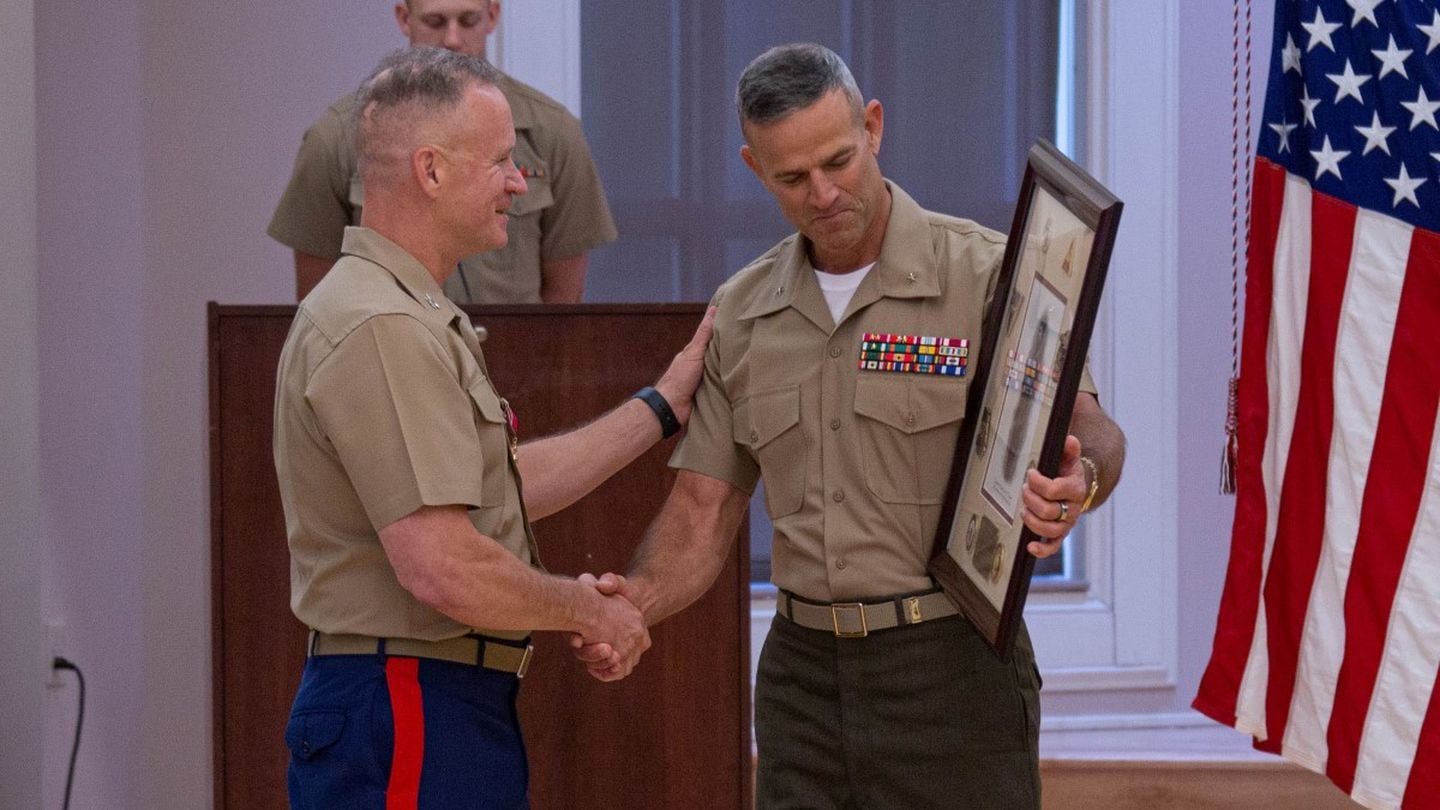
Retiring Marines have to give 6 months’ notice, up from 4 months
Want to retire from the Marine Corps? The service now requires at least six months' heads up.
Marines who wish to retire from the Marine Corps now have to let the service know at least six months before their planned retirement dates, up from four months.
The change, announced in a Marine administrative message Friday, comes as the Corps is overhauling its approach to retaining Marines, in an initiative called Talent Management. The service has tried to keep more experienced Marines in its ranks by offering incentives, financial and otherwise, and by making it easier to reenlist for second or third terms.
But the Talent Management initiative also has implications for Marines who are nearing the end of their time in uniform.
The Corps has a plan to stop Marines from leaving. Is it working?
“One of the elements of Talent Management is predictability, and to facilitate it for assignments and related actions,” the administrative message reads.
Effective immediately, Marines must submit their requests for retirement not more than 18 months and not less than six months before the day they would like to retire. Previously, they had to submit their requests not more than 14 months and not less than four months out, according to the separation and retirement manual.
The new time limits also apply to Marines who resign from the Corps.
The Corps’ Manpower and Reserve Affairs division reviewed the previous four-to-14-month window and found it didn’t give Marines enough time to plan for a smooth transition from the ranks, Marine spokeswoman Capt. Sarah Eason said via email to Marine Corps Times on Friday.
“A model that requires a 6-month to 18-month lead time ensures a Marine has sufficient time to complete all requirements associated with transition, while also allowing the service to more effectively forecast the availability of manpower capacity to meet service requirements,” Eason said.
Before Marines leave the service, they need to complete the Transition Readiness Seminar, Permissive Temporary Additional Duty, a final physical, unit checkout requirements, terminal leave and more, Eason noted.
The Corps’ director of manpower management may approve a retirement or resignation request for a date other than the one a Marine has requested “based on the needs of the service, service limitations, or the laws and policies related to retirements/resignations,” according to the Marine administrative message.
Enlisted Marines and officers alike are eligible to become retirees — who receive pensions, along with a host of other benefits — after 20 years’ active duty service. Enlisted Marine retirees with less than 30 years of service technically get transferred to the Fleet Reserve, where it is possible they could be ordered back to active duty.
The tweak to the retirement process isn’t the only policy pertaining to soon-to-be-veterans that the Corps’ Manpower and Reserve Affairs division has recently reassessed.
In October, the Corps released a document announcing cuts to the time that Marines could spend training at civilian workplaces before leaving active duty. Service members in that transition program, called SkillBridge, spend the final months of their active duty commitments at jobs in the civilian sector rather than at their military jobs.
The Marine Corps later pulled the “premature” document from its website, and the cuts to SkillBridge didn’t actually go into effect, Marine spokeswoman Maj. Danielle Phillips said in November. But Phillips acknowledged the Marine Corps was evaluating its SkillBridge policy “to ensure we balance the needs of the individual Marine with Congressional intent and a mission-capable Marine Corps.”
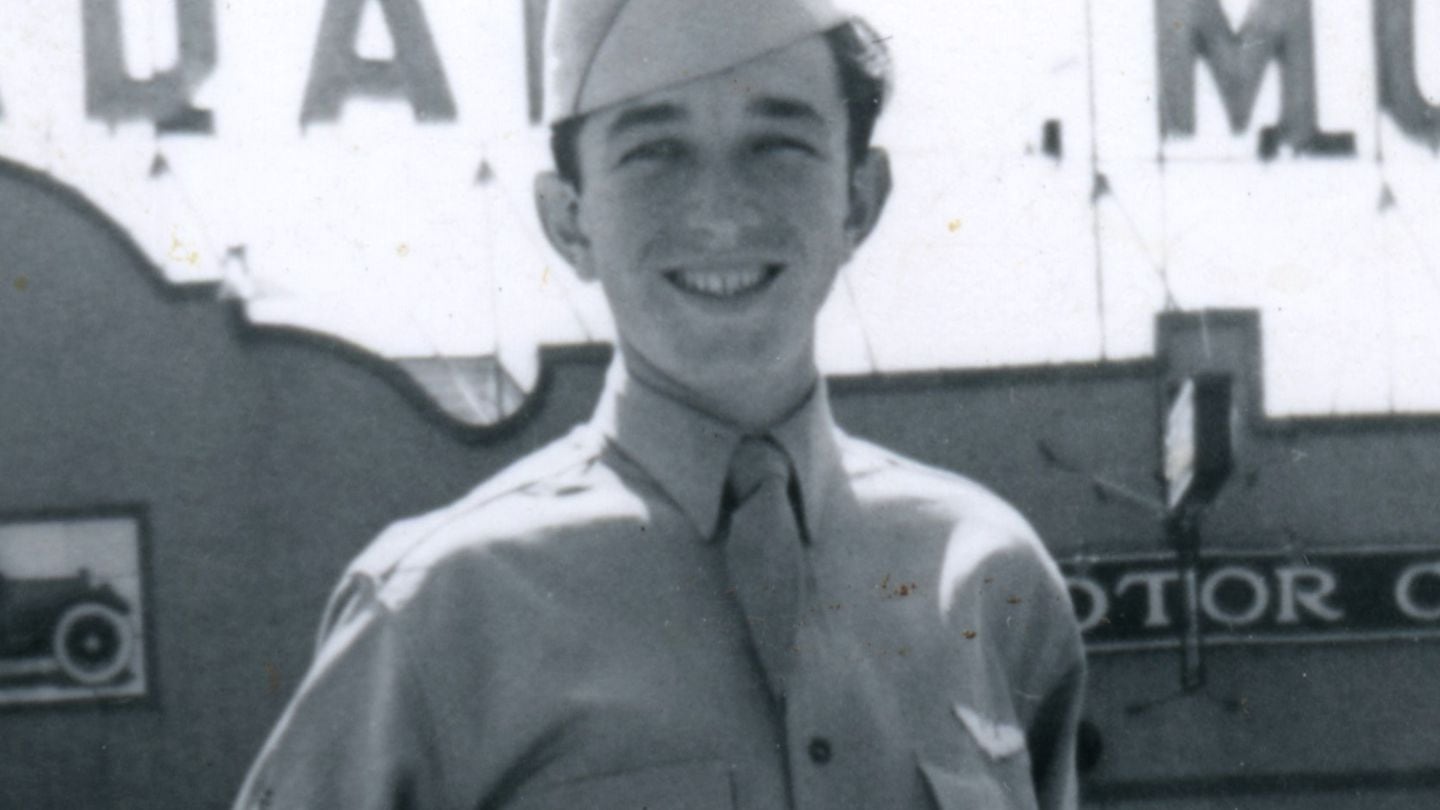
His father never spoke of WWII. His flight logs told the story for him
Historian and author Howard Mansfield had vowed to never write another word about World War II. Until another one fell into his lap.
Historian and author Howard Mansfield had vowed to never write another word about the Second World War. Yet a decade after his work, “Dwelling in Possibility: Searching for the Soul of Shelter,” another World War II story fell into his lap — quite literally. And it was one that he could not ignore.
His father, Pincus Mansfield, had served with the 453rd Bombardment Group of the Eighth Air Force, but, like many veterans, Pincus had never spoken to his sons about his time serving in the flak-filled skies of occupied Europe.
It wasn’t until 65 years on, as Howard and his brother began clearing out their father’s home, did they happen upon a treasure trove of histories past.
“Cleaning up one day, in a small drawer with his cufflinks and tie clips, I found some small, unlined, pocket-sized notebook pages, folded over and tossed aside, sitting as they had for almost sixty-five years,” Mansfield writes in his prologue to “I Will Tell No War Stories.”
“It was an account of each bomber mission he had flown as he had recorded it when he was nineteen and twenty years old. I had no idea such a record even existed.”
Mansfield seamlessly weaves the tracing of his own father’s story with the broader implications of history and memory.
Combat, as Mansfield’s research reveals, and as his father intimately knew, is an “experience so overwhelming that words diminish it, as if trying to draw a frame around the infinite.”
That didn’t stop Mansfield from trying, as he “began to undo the forgetting as best [he] could.” His latest, “I Will Tell No War Stories” is a testament to that.
Can you tell me about discovering your father’s war ‘twice’?
The first time I was in Wales — they have these great long-distance paths over there, all throughout the countryside. I was on one that runs along the Irish Sea and one night, I’m in this pub — because that’s where you’re going to be in this little village — and I get talking to this guy. I told him my father flew during the war so he said to me, “You’ve got to come upstairs to our meeting and see this film.” He introduces me as this honored guest because my father flew in the Eighth Air Force during the war.
They showed me this film — “Target for Tonight” — that has stayed with me to this day. It was like no war movie I’d ever seen. It was small. It was quiet. There were no special effects. It was only 45 minutes. But you came away with a real understanding of World War II from the British perspective. But what really came across to me was how unrelenting the industrial bombing was. You got up in the morning and if the weather was good, you’d go out. So at that point, I thought, oh my gosh, I bet my dad lived a life much like that of the film.
The second time just happened a few years ago. My dad never talked about the war just like most of the veterans. There were a couple of hints around the house, an old uniform in the basement, that sort of thing. But during the last year of his life we were cleaning up his home to move him to a veteran’s nursing home, and there was this little diary that he had kept during his bombing missions. They were not supposed to do this of course, it was strictly verboten for airmen to keep diaries at all, but a lot of them did.
I was just astounded to see it folded over and left. It had been sitting like that for 65 years.
From that I was able to start putting together the story of how he had served, where he was, and what he had gone through. He received two Purple Hearts, something that he had never mentioned.

Can you walk me through what your research process was like — especially with your father’s records destroyed in the 1973 fire?
At first I was like, “oh, I’ll request his military records.” But yes, I learned that after the 1973 St. Louis fire they lost maybe 85 percent of the U.S. Army Air Forces’ records from World War I through the early ‘60s. It’s just a phenomenal loss. So I had to put it together from other sources.
So a couple of key things: One, is I remembered the name of his pilot. I found his son who had the same name. I wrote him a letter, an old-fashioned letter, which he answered and called me back. Miraculously he had his father’s pilot logbook, so I had the missions my father flew and I knew when he had been hit because I had his Purple Heart papers, which I also found in his house.
He was in the 453 BG [bombardment group] and a couple of histories have been written on that, which I was able to use. From the Air Force Historical Research Agency I got miles and miles of microfilm. Once I decoded that sort of military way of categorizing things, I was able to see all the planning for the missions.
It was primarily the miles and miles and microfiche that gave me a feeling for what it was like — it gave me a real feeling for all the losses of the airplanes. In the book there is a place where I list all the planes and how they were lost. I think it’s just chilling.
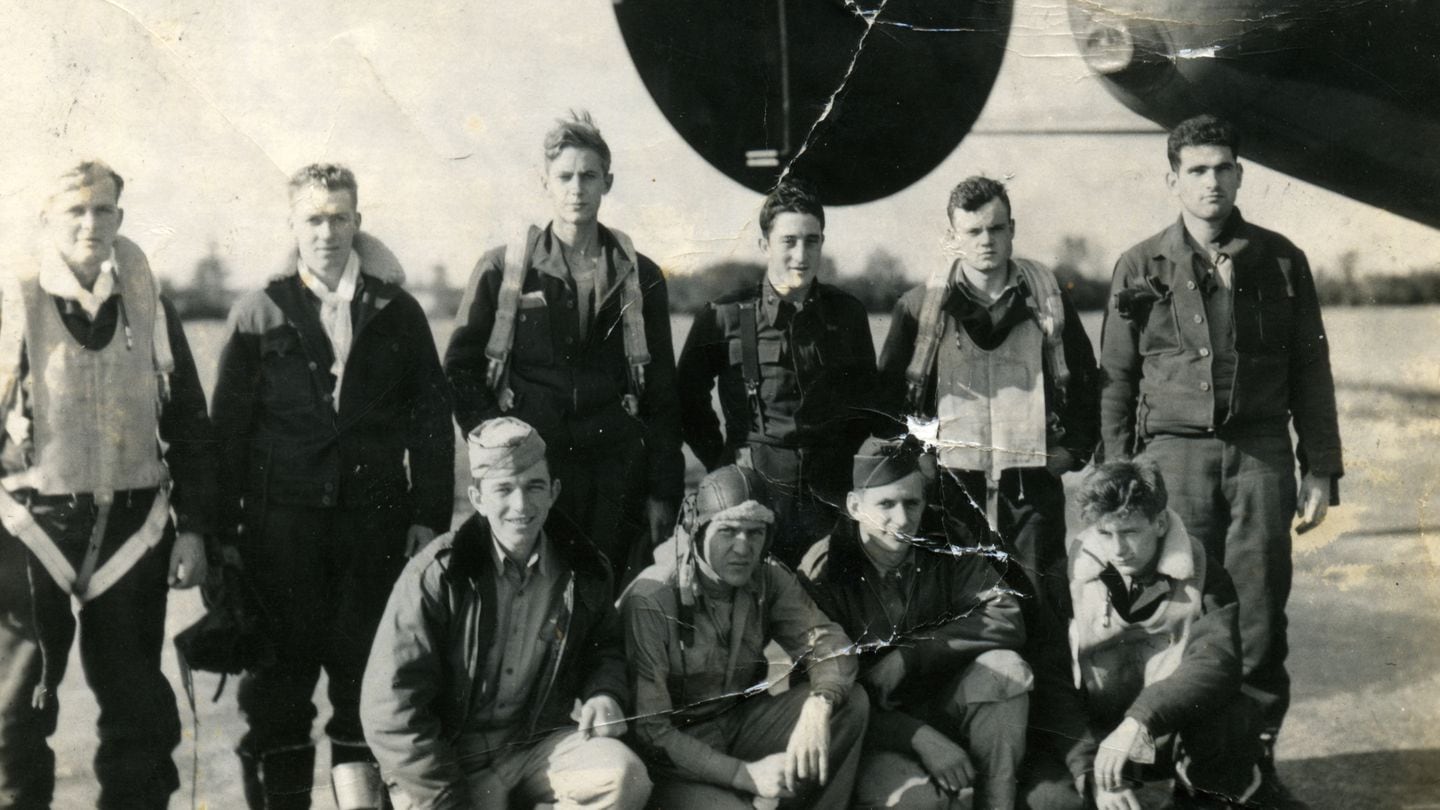
As you combed through your own father’s history, ‘undoing the forgetting,’ so to speak, how did your relationship with, or understanding, of him evolve?
By the time I was doing this he had died, but what I came to understand is why he didn’t want to talk about it.
I think there are two things, which was the cause for a lot of his generation. One, is remorse. Remorse about killing.
My father had been dead a year or two and my brother had the last few things in a storage locker. We were going through it and opened up this box that contained these two cassettes. I don’t remember him recording on microfiche and he must’ve just thrown them in a drawer or something. But in it, he talks about, oh my gosh, it was such an incredible thing. He’s home and my brother is 3, 4 years old. They’re watching TV and it’s a dark documentary kind of thing. They’re dropping bombs on cities and my father, who is watching says, “Oh my God.” That always bothered him.
And primarily, Ernie Pyle wrote this so well, and I’ll paraphrase but, “We did this so you don’t have to think about it. Go live in peace. Just go.”
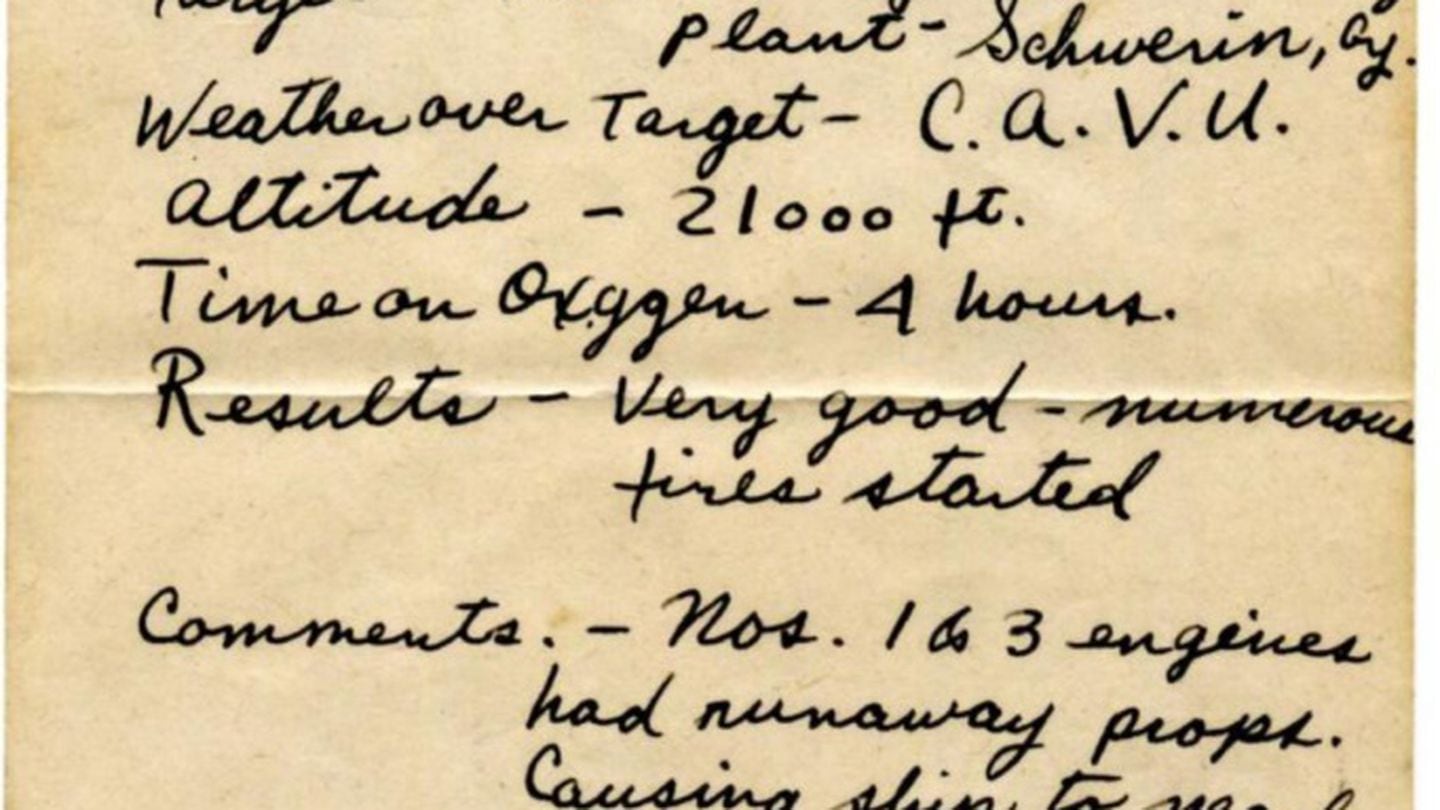
Military history is not always strategy or battle tactics, but the humanity (or lack thereof). Their silence gave us peace. How do you reconcile that as both a son of this generation, but also as a historian?
Well, as a historian, I wish that people would have told us more. And particularly, actually, particularly now, because there’s two things about what happened in World War II that I think people should never lose track of. One was how vast the destruction was in Europe. And the other thing is that this can’t happen again. Just can’t.
I do wish he had told us more at a certain age you know. All the guys on the block where I grew up had been in the Marines, the Navy, the Army. None of them talked about it. Who knows what they had seen or what they had done.
Your words ‘The commemorations and retellings of World War II became part of our forgetting’ reminded me of Milan Kundera’s book, ‘The Book of Laughter and Forgetting.’ How do you think the collective memory of World War II has diminished or obscured realities?
That’s an immense question. I’d say the films we grew up watching, most of them couldn’t be as fierce as what happened. Every now and then that happens — the recent film “Dunkirk,” the first 20 minutes of “Saving Private Ryan” — but most films have been watered down.
It also becomes kind of this thing that always happens in history where you go from the end, and read back in the beginning, “Oh, of course, we were gonna win.” Which wasn’t the case at all. A lot of things could have broken different ways, so I think it’s very hard to connect with.
I flew in a restored B-17 recently and I got a feel for how incredibly small inside it was. How loud it was to fly in that bomber, but even that was so cleaned up and sanitized. There was no blood. Vomit. Fear. Everything was wonderful. And that’s not the way it was.
You’re up at 20-25,000 feet in the air and then wait, you’re open to the weather? The plane isn’t pressurized?
It was all just physically exhausting. There’s long hours when nothing happens, and then those moments with just everything happens and you can be killed. It’s a very strange mix of tedium and possible death.
You vowed to never write about World War II again after finishing ‘Dwelling in Possibility.’ Do you feel the same sentiment now after?
Yes, I’m tired of having things destroyed. Writing about it was really a very upsetting exercise. You really have to open yourself up to that kind of destruction and suffering and try to portray it honestly.
I’m sure the mental toll of sifting through archives revolving around constant death and destruction, but even then, that in itself gets sanitized.
Yeah, exactly. You mentioned rivet counters — and yes, you gotta have those guys that check things, but sometimes they just get too locked in, lost in the hardware of the whole thing. You miss the point that these were boys flying the hardware.
You have to keep your eye on what was going on.

US military to expand universal pre-K at dozens more bases this fall
The U.S. military will rapidly expand its universal pre-K program to another 79 primary schools, for a total of 80 locations, in the 2024-2025 school year.
Leila Rojas loves school.
Since she became one of the first 4-year-olds enrolled in the Defense Department’s free universal preschool program, which launched last year at M.C. Perry Primary School at Marine Corps Air Station Iwakuni in Japan, Leila is thriving academically, socially and emotionally, said her mother Yadira Rojas.
“It’s been amazing for us,” Yadira Rojas said. “Leila talks about her teachers all the time, about how much they teach her, how nice they are, and how they play with her all the time.”
Now thousands more military children will get that same opportunity as the Defense Department prepares to open universal pre-kindergarten at nearly all primary schools on U.S.-run bases worldwide this fall.
The Department of Defense Education Activity, which manages schools on U.S. military bases around the world, launched its universal pre-K program in 2023 with a cohort of 65 4-year-olds at one school — M.C. Perry. The initiative’s success in Iwakuni has prompted DODEA to rapidly expand universal pre-K to another 79 primary schools, for a total of 80 locations, in the 2024-2025 school year.
The remaining 10 primary schools in the DODEA system will get pre-K over the next several years, pending construction and renovation.
Once pre-K classes have arrived in all 90 primary schools, an estimated 6,000 4-year-olds will be eligible, said DODEA spokesman Will Griffin. Any child who will be age 4 on or before Sept. 1 of a coming school year may enroll.
Parents can register through the DODEA Student Information System, but there’s no registration deadline because military families move throughout the year. Parents can visit dodea.edu/upk for more information and to enroll their child.
Families’ reactions to the fledgling program have been very positive, Griffin said.
“One of the struggles … with dual-military families or families with two working parents, service member and spouse, is the challenge in ensuring their kids are in a good situation, whether it’s child care, the Child Development Center, or some kind of educational opportunity,” Griffin said. “This is absolutely a win-win. They have the opportunity to know their child is in a good place, a nurturing, developmental environment that gets them started with a strong foundation to begin kindergarten.”
Yadira Rojas said she’s glad many more 4-year olds will experience what her daughter has at M.C. Perry.
“There’s no way to describe how safe I feel with my child being there,” Rojas said. “I love the teachers and everyone in the classroom. They keep me updated on my child and how she’s doing in the school.”
Rojas, who is employed at the Exceptional Family Member Program office on base, said the pre-K “has helped tremendously with child care. I feel the pre-K is preparing her for kindergarten. And … it gives us breathing room with the finances.”
The U.S. military will spend $75 million to fund universal preschool at the 80 locations next school year, Griffin said.
Supporters of publicly funded universal pre-K contend that starting high-quality education earlier can make a positive difference in a child’s future. Some states offer pre-kindergarten through a patchwork of different public and private programs and eligibility requirements.
The Defense Department operates 160 schools around the world, with about 66,000 students. The vast majority of military children attend schools outside the gate.
The 80 pre-K locations will be in schools with space to accommodate preschool classes, among other requirements. In general, restrooms must be accessible from the classroom; the classroom must be on the first floor of the building; a kitchen must be available for family-style dining and snacks; and the playground must have equipment designed for 3- to 5-year-old students, Griffin said.
Of the 10 schools that are slated to open universal pre-K later on, four are at Fort Campbell, Kentucky. Those programs are expected to begin in the 2025-2026 school year.
The other six include: Parker Elementary School at Fort Novosel, Alabama; Ansbach Elementary School, Ansbach, Germany; Aukamm Elementary School and Wiesbaden Elementary School, Wiesbaden, Germany; Ramstein Elementary School, Ramstein, Germany; and Kleine Brogel Elementary School, Kleine Brogel, Germany.
Those last six require more extensive renovations or construction, Griffin said. DODEA hasn’t yet set a date to open universal pre-K at those schools.
Providing universal pre-K “means access and equity for all our eligible children,” said Lori Pickel, chief of the curriculum and instruction division at the DOD school headquarters. “Before, we’ve provided pre-K for some. Now the universal entry point for all children into DODEA will be 4 years old.”
Unlike at child development centers, “universal” pre-K is named as such because it has no priority enrollment. Signing up is voluntary and open to all students who meet the eligibility criteria.
The program offers full-day instruction for all, including at schools which previously offered half-day preschool.
Classes will use The Creative Curriculum for Preschool, Pickel said, which is research-based and addresses student learning on the development continuum, and helps teachers target instruction to meet individual students’ needs. It’s play-based curriculum and instruction, and is also aligned with the school system’s college and career ready standards for their K-12 students.
“What they explain to the parents, and what I see when I volunteer, is they use play-based learning,” said Yadira Rojas, who sometimes volunteers in the school. She said the pre-K classrooms have different play areas, such as a kitchen and a science area. For example, when the children learned about winter, they made snow with baking soda and shaving cream, connecting it to a science lesson.
“[Leila] loved that activity. We had to make snow at home, too,” Rojas said.
Like other DODEA classes in kindergarten through third grade, the maximum ratio of students to teachers is 18-to-1, said Michelle Alexander, early childhood branch program manager for curriculum and instruction at DOD school headquarters. Each classroom will have a certified teacher and a teaching aide.
The school systems have hired about 80% of the pre-K teachers needed, and are continuing to work on hiring educational aides. Griffin said the jobs are great employment opportunities for military spouses; Pickel and Alexander are both spouses of military retirees.
“It’s been a long time coming, and it’s here,” Alexander said.

All the US assets that helped repel Iran’s attack on Israel
Multiple Navy warships, Air Force fighter jets and a missile defense battery helped take out Iran's attack on Israel.
A host of American military ships, jets and munitions played a vital role in repelling Iran’s attack on Israel over the weekend — an unprecedented barrage that involved hundreds of missiles and attack drones.
The Iranian attack on Saturday, less than two weeks after a suspected Israeli strike in Syria that killed two Iranian generals in an Iranian consular building, marked the first time Iran has launched a direct military assault on Israel, despite decades of enmity dating back to the country’s 1979 Islamic Revolution.
An Israeli military spokesman said that 99% of the drones and missiles launched by Iran were intercepted.
Part of that success rate had to do with the U.S. forces who aided the Israelis in taking out the airborne threats.
From the Mediterranean Sea, the Navy destroyers Carney and Arleigh Burke shot down multiple ballistic missiles in the attack, according to a defense official and media reports.
Carney has become a workhorse of the Navy in recent months and has been crucial to shooting down missile and drone attacks over the Red Sea sent by Iran-backed Houthi rebels in Yemen since October.
The salty sailors of the warship USS Carney have left the Middle East
The ship left the Middle Eastern waters of U.S. Central Command earlier this month and entered the Mediterranean. Officials at the time declined to say why it was on the move.
Meanwhile, White House officials confirmed that the Air Force’s 494th and 355th fighter squadrons also played a role in Israel’s defense, racking up dozens of aerial takedowns.
President Joe Biden reached out to the squadrons to personally express his thanks for “their extraordinary airmanship and skill that was displayed throughout this multi-hour engagement.”
A Patriot missile defense battery based in Irbil, Iraq, also shot down Iranian weapons, officials told journalists.
This weekend’s attack came not only from Iranian territory, but also from proxies in Iraq, Syria and Yemen, officials said.
What comes next remains unclear.
Iran had about 150 ballistic missiles capable of reaching Israel from Iranian territory, and appears to have used up most of that current stockpile in its weekend attack, retired Gen. Frank McKenzie, the former head of U.S. Central Command, said Monday.
McKenzie discussed the attack in a panel discussion with the Jewish Institute for National Security of America, a Washington-based think tank and lobbying group.
McKenzie argued that Iran’s expenditure of those 150 long-range missiles, out of a total ballistic missile stockpile of about 3,000, showed that Iran’s barrage on Israel “was a maximum effort. It was an indiscriminate effort.”
The U.S. and its partners in the region are easily able to track when Iran brings its ballistic missiles out of storage and positions them on launch pads, he said.
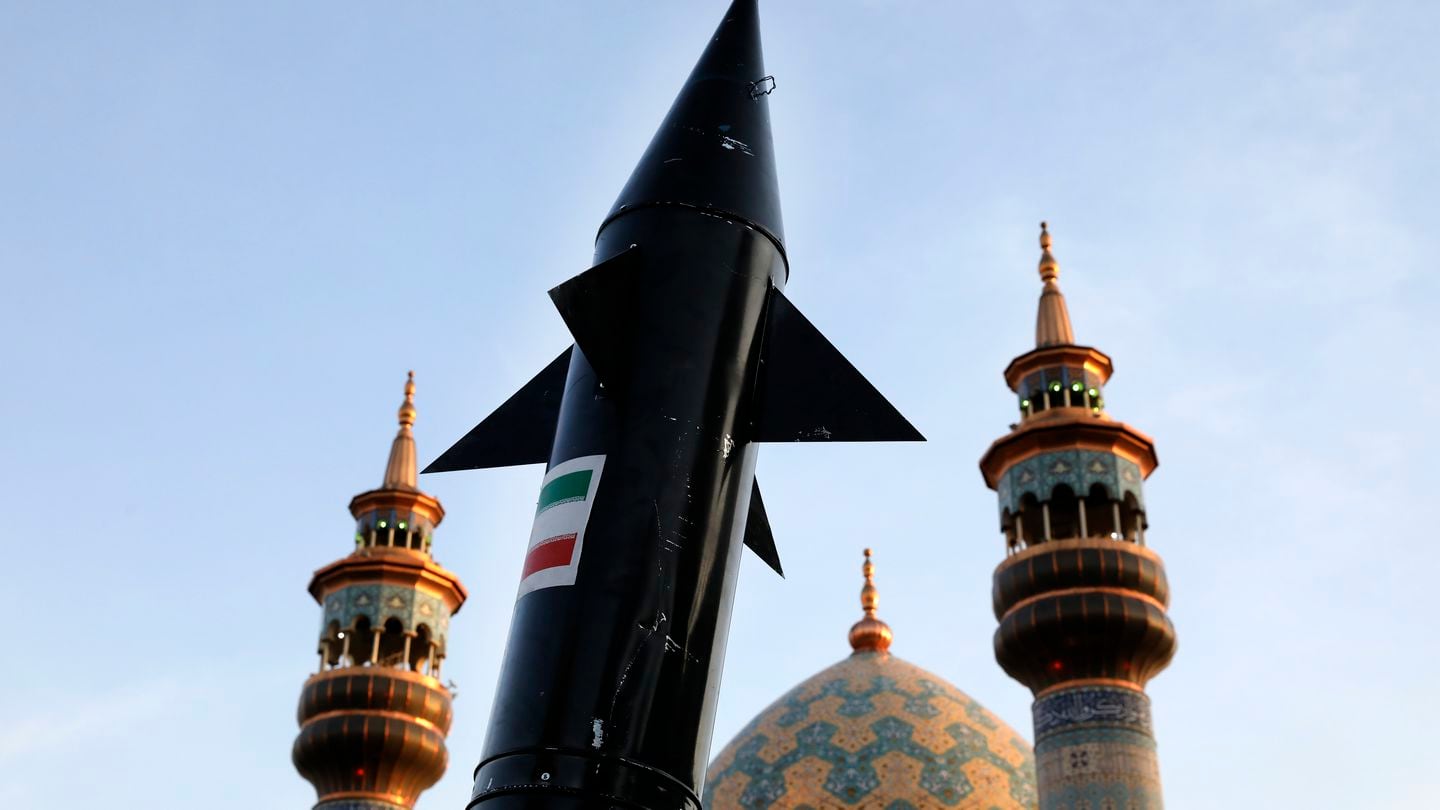
When Iran launches, deep space sensors detect that immediately, he said. Radars in the region then catch when any missiles break the radar plane, he said.
Especially given the distance involved, “it is hard for Iran to generate a bolt from the blue against Israel,” McKenzie said.
World leaders are urging Israel not to retaliate after Iran launched an attack involving hundreds of drones, ballistic missiles and cruise missiles.
British Foreign Secretary David Cameron told the BBC on Monday the U.K. does not support a retaliatory strike, while French President Emmanuel Macron said Paris will try to “convince Israel that we must not respond by escalating.”

Deported veterans struggle to access VA services, study finds
Historically, policies involving the deportation of veterans have not always been closely followed.
Deported veterans face significant barriers accessing a variety of veteran-centric services, including health care benefits from the Department of Veterans Affairs, according to a study by the University of California-Berkeley School of Law.
The study, released on April 8 by the Veterans Law Practicum at UC-Berkeley, noted deficiencies in two pathways that allow deported veterans to access VA programs: humanitarian parole and the VA Foreign Medical Program.
“The law promises veterans access to the benefits and care many need to survive, no matter where they are in the world,” the report states. “To breathe life into this promise, we urgently need change. Otherwise, deported veterans will continue to suffer and die in exile.”
Humanitarian parole granted by the Department of Homeland Security allows deported veterans temporary reentry to the United States to access VA health care. However, applications for humanitarian parole are often denied and the cost of travel can be “prohibitive,” according to the report.
“There are a lot of deported veterans who are not able to subsist in the countries to which they’re deported,” Eric Provost, a Navy veteran and one of the authors of the report, told Military Times. “They don’t have access to things like VA health care, which they may be entitled to. A year just isn’t enough to ensure continuity of care and that they’re getting the treatment they need.”
The VA’s Foreign Medical Program, which provides health care from non-VA providers overseas, presents another opportunity for deported veterans to receive care. However, the report noted the program only covers treatment for “disabilities previously recognized as service-connected by the VA,” and many veterans are deported before they complete the disability compensation process.
There is also the question of the program’s reach in smaller countries, Provost added. While veterans have more options to apply for the program in larger countries, such as Mexico, other veterans, such as those residing in smaller nations — Honduras or El Salvador, for example — struggle to apply, Provost said.
“All veterans have access to [VA] benefits, regardless of their immigration status,” Provost told Military Times. “The fact that they’re deported has no bearing on whether they should be getting those benefits.”
The report recommended granting humanitarian parole more liberally, expanding the Foreign Medical program to include non-service-connected conditions and not requiring upfront payment for care, among other suggestions.
Mixed policies for non-citizen vets
The Immigration and Nationality Act allows for non-citizen service members to acquire citizenship if they are “lawful permanent residents” — also known as green card holders.
However, some veterans do not apply for citizenship — or satisfy the criteria for it, according to a 2019 Government Accountability Office report. “Bureaucratic and logistical obstacles” also hinder some veterans’ abilities to file for citizenship, the report stated.
Approximately 94,000 veterans do not have U.S. citizenship, leaving them vulnerable to deportation if they violate certain laws, regardless of their service record, according to the National Immigration Forum.
Historically, policies involving the deportation of veterans have not always been closely followed.
The 2019 GAO report found that Immigration and Customs Enforcement did not follow its own policies on tracking cases of non-citizen veterans who may be deported. Between fiscal year 2013 and 2018, 250 veterans were under threat of deportation, and another 92 had been deported.
The GAO recommended that ICE collect and maintain complete data on veterans currently under threat of deportation, or who have already been deported.
President Joe Biden in February 2021 signed an executive order mandating government agencies to review their immigration policies and propose new changes. In July 2021, the Department of Homeland Security and the VA announced the creation of the Immigrant Military Members and Veterans Initiative.
As of December 2023, 93 deported veterans have returned to the U.S. through the program, according to the Veterans Law Practicum report.
There are legislative opportunities, too, to solve the gaps in accessing benefits for deported veterans, researchers noted. The report’s authors specifically call for the passage of the Veteran Service Recognition Act. Some provisions in the legislation include conducting a study on the number of veterans deported from the U.S. and better equipping military procedures to naturalize service members, according to the report.
So far, lawmakers have not voted on the legislation. The bill passed the House in 2022, but did not receive a vote in the Senate. It was reintroduced by a bipartisan group of House lawmakers in July 2023, although it has yet to receive a vote in the lower chamber.

Marine Corps’ camouflage uniform shortage has eased up
Marine recruits now are receiving a full issue of the camouflage combat utility uniforms.
The Marine Corps’ yearslong camouflage uniform shortage is coming to an end.
The Corps first observed a shortage of the woodland-pattern combat utility uniforms, the everyday outfits often known as cammies, in summer 2022. The shortage prompted some rare flexibility from the service that otherwise expects rigid adherence to uniform standards.
Meanwhile, Marines who were looking to replace uniforms that had gotten worn out, lost or tactically acquired had to get creative with tailoring or purchase secondhand items, often at a premium, Marine Corps Times previously reported.
But the worst of the shortage is over, according to the Marine Corps.
The shortage had forced the Corps to issue only two sets of woodland cammies and one set of desert cammies to recruits, instead of the usual three woodland sets and two desert sets, Marine spokesman Maj. John Parry told Marine Corps Times in August 2023. That meant recruits sometimes had to train in flame-resistant organizational gear, or FROGs, a uniform typically reserved for deployments.
These days, however, recruits are once more receiving the full issue of uniforms, Parry told Marine Corps Times via email on Tuesday.

And the Marine Corps’ on-base exchanges have “adequate stocks” of cammies on their shelves, Parry said.
The Corps expects the shortage fully will be resolved by the end of June, according to Parry.
Some signs of the shortage linger.
The Navy Exchange website still lists combat utility items as out of stock, as of Thursday. In an email to Marine Corps Times, Kristine Sturkie, a spokeswoman for the Navy Exchange, attributed the lack of Marine utility uniforms in its stores or online to “the current USMC course of action and [the Defense Logistics Agency’s] supply chain availability.”
Marine camouflage uniform shortage won’t be fixed until summer 2024
Unit leaders still are authorized to allow Marines to wear desert-colored cammies or FROGs, according to Parry. Marine Commandant Gen. Eric Smith said in September 2023 he was offering commanders that leeway because of the shortage.
“What we cannot have is a situation where a Marine is wearing unserviceable cammies, because that looks bad for the Corps, and we can’t have a situation where that Marine is being given a hard time about those unserviceable cammies,” Smith said.
Chuck Lambert, CEO of American Apparel Inc., the primary manufacturer of the uniforms, previously told Marine Corps Times the shortage arose from inflation and a tight labor market in the wake of the COVID-19 pandemic.
Those factors made production more expensive, causing trouble for manufacturers whose contracts had them selling uniforms at prices that had been fixed years earlier, according to Lambert’s explanation.
The Defense Logistics Agency in 2023 awarded three new combat utility uniform contracts, including to American Apparel Inc., in an apparent effort to alleviate the shortage, Marine Corps Times previously reported. American Apparel Inc. has no relation to the international retail clothing company of the same name.
“All vendors are producing and shipping on schedule,” Parry said Tuesday.
The Marine Corps consistently requires approximately 25,000 combat utility uniforms a month from its vendors, Lambert said via email to Marine Corps Times on Tuesday. American Apparel Inc., which has been involved with manufacturing those uniforms since they were rolled out in the early 2000s, now produces approximately 16,000 of that monthly total, according to Lambert.
“It’s been a very difficult time the last three to four years,” said Lambert, who praised his employees for their handling of the challenges in producing the uniforms. “We are glad that this effort and attitude has been beneficial to the Marines and their needed stock levels.”
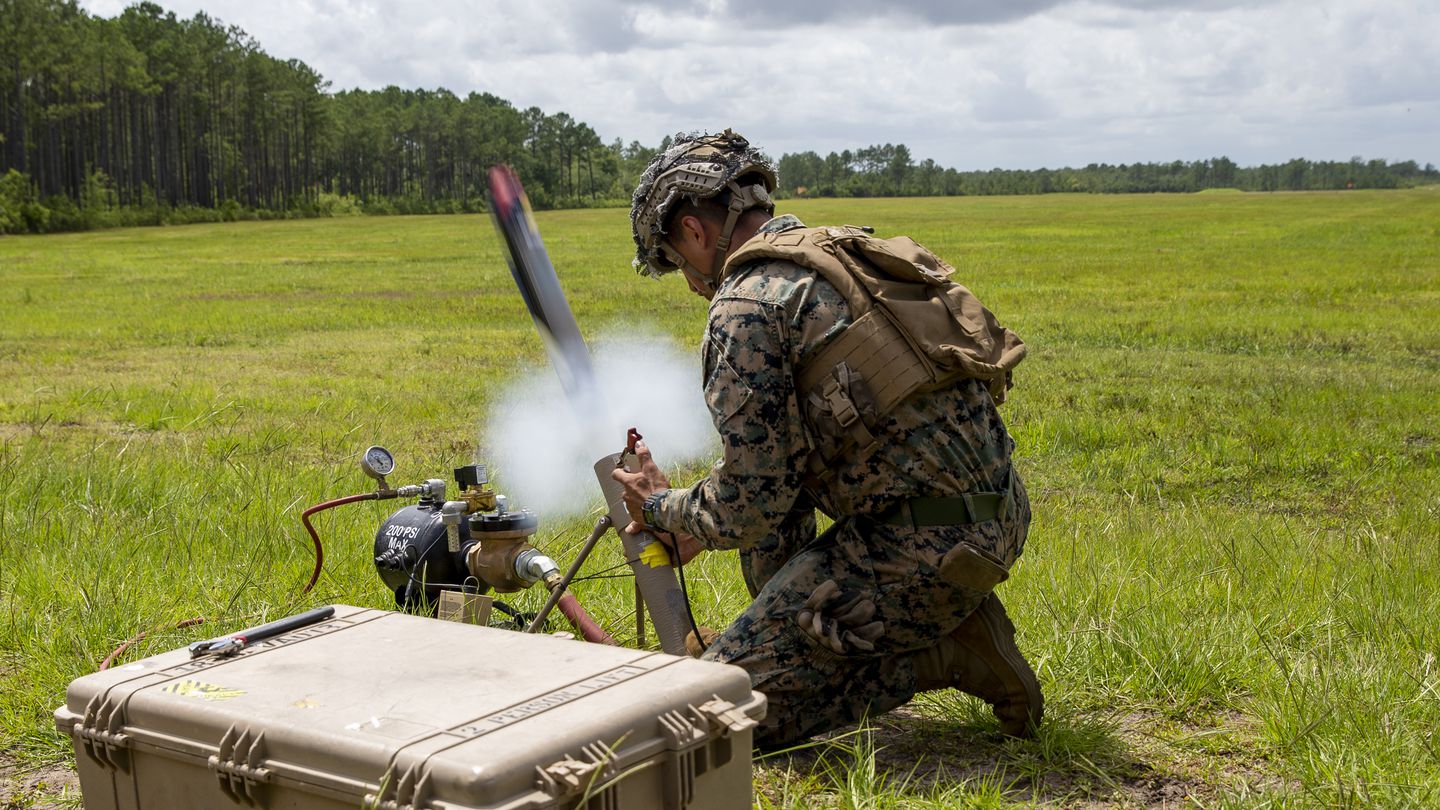
Marines pick three companies for loitering munitions program
The weapon would give squads and platoons air firepower at their fingertips.
The Marine Corps has selected three companies to compete for its light loitering munitions program, which seeks to equip small units with an armed drone for over-the-horizon fire missions.
AeroVironment, Anduril Industries and Teledyne FLIR will compete for the potential $249 million, five-year contract for the Organic Precision Fires-Light, according to awards notices posted April 10 on the government’s contracting website.
The light fires system is a man-packable, armed loitering drone for rifle squads and platoons. Loitering drones often have built-in warheads and strike a target by crashing into it. They are sometimes called suicide or kamikaze drones.
Assistant Commandant Gen. Christopher Mahoney said at the Defense One Summit in March that the light system was “performing very well.”
“This is extremely significant at small and large unit levels, pushes the effective range out further,” Mahoney said.
As far back as 2018, Marine officials have been looking to put armed drones in the hands of infantry squads.
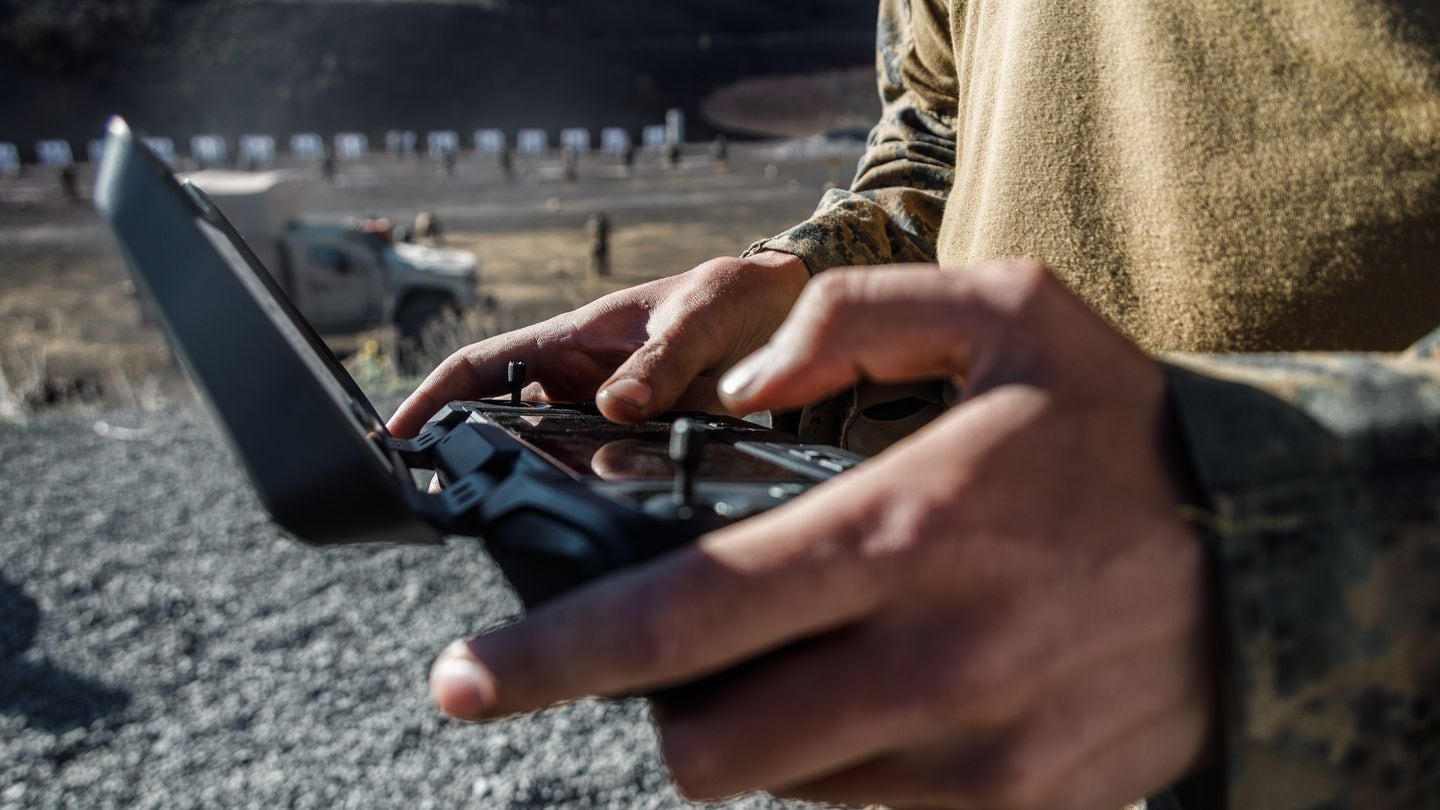
At a Marine Corps Warfighting Laboratory roundtable in July 2018, Capt. Matt Cornachio, then a fires project officer with the lab, said the service had successfully tested a single operator running six “suicide” drones and sought to increase that to 15 with further experimentation.
That advancement would allow infantry squads to conduct their own close-air support and electronic warfare, experts said.
Teledyne FLIR Defense announced its selection for the contract in a recent press release, noting the company would deliver the first 127 loitering munition systems for test and evaluation later this summer.
The light system is only one part of a larger effort to provide loitering munitions to Marines.
At the same March event, Mahoney said that the Corps has had challenges in both technical and performance measures for the mounted system.
The Marine Corps released its first request for information on the Organic Precision Fires-Mounted system in 2019. The mounted system was originally geared toward giving the light armored reconnaissance battalions an armed drone capability.
In 2021 the Marines awarded a contract to develop the mounted system to Mistral Inc. and UVision LTD. The Corps now wants it to mount the Light Armored Reconnaissance Vehicle, Joint Light Tactical Vehicle and the Long Range Unmanned Surface Vessel, a semi-autonomous watercraft being developed by the Marines.
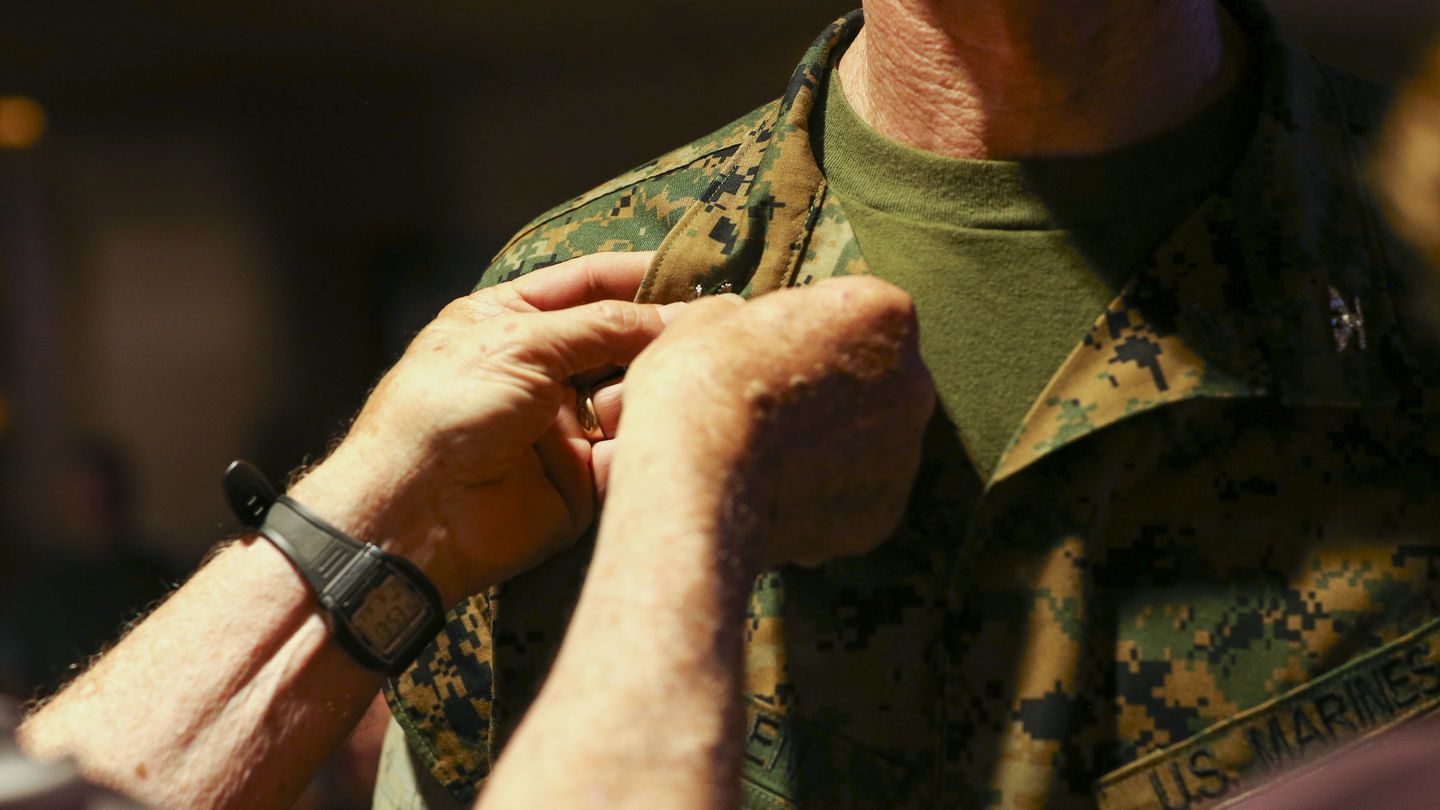
Marine Corps plans to give some officers temporary promotions
Marine officer retention dropped slightly from fiscal year 2019 to 2023.
The Marine Corps is seeking the authority to promote some officers to the rank of lieutenant colonel and colonel temporarily, in a bid to fill jobs with a shortage of leaders.
These officers would receive the pay and wear the rank insignia commensurate with the higher grades while they occupy particular billets, according to a March 29 Marine administrative message.
“This pilot program would temporarily promote qualified Marine Corps officers with critical skills while they are filling key billets,” Marine spokeswoman Capt. Sarah Eason said in an emailed statement to Marine Corps Times on Friday.
The Navy secretary, Carlos Del Toro, would designate which billets are eligible for the Marine Corps’ spot promotions, according to Eason.
The Army and Navy already have similar programs, called brevet promotions and spot promotions, respectively.
Marine majors and lieutenant colonels would be eligible for the promotions in fiscal year 2026, according to the Marine administrative message.
“This pilot, like other Talent Management initiatives, allows the service to better leverage Marines’ talents and incentivize retention,” said Eason, referring to the Corps’ plan focused on keeping experienced Marines from leaving the service.
The Corps has a plan to stop Marines from leaving. Is it working?
Enlisted retention has increased since the Marine Corps rolled out the Talent Management plan in 2021, but officer retention dropped slightly from fiscal year 2019 to 2023, Marine Corps Times previously reported.
In a statement to Marine Corps Times in January, Eason attributed that dip to the cutting of certain jobs, the now-rescinded COVID-19 vaccine mandate and some officers delaying departures until the economic uncertainties of the pandemic had diminished. The officer retention rate now is trending back to pre-pandemic norms, the spokeswoman said.
To be eligible for the spot promotions, both majors and lieutenant colonels would have to be eligible for permanent promotions in fiscal year 2026 but have been passed over for those promotions, according to the Marine administrative message.
The message specifies that majors can receive spot promotions if they hold the military occupational specialty 0102, or manpower officer. These officers “plan, coordinate, execute and/or supervise the functions of administration (general administration, operational administration, manpower administration, and personnel administration) in their respective commands and organizations,” according to the Corps’ military occupational specialty manual.
The message doesn’t specify the military occupational specialties that lieutenant colonels must have in order to snag temporary promotions to colonel.
The spot promotions would last as long as the officers occupy the qualifying billets. Once the officers leave those billets, they would return to their previous ranks, unless they have entered other qualifying billets or have secured permanent promotions, according to the message.
One key difference between spot promotions and frocking — the practice of giving a service member the uniform and title of a higher grade before a promotion — is that frocked troops don’t receive the pay commensurate with the higher grades.
Although Eason said the Corps has just sought the authority to perform spot promotions, the Marine administrative message describes how the promotions “will” work and declares the selection boards will convene in early May at Marine Corps Base Quantico, Virginia.
“More information will be provided at a later date,” Eason said.

Marines at Trump resort did not break rules on politicking in uniform
A viral photo of uniformed Marines at an event at former President Donald Trump's Florida home was not a violation of military rules, officials said.
Marine Corps officials said a viral photo of four uniformed service members posing at former President Donald Trump’s Mar-a-Lago estate did not take place during a political fundraiser, but instead at an approved nonprofit event without any connection to the Republican presidential nominee.
In a statement posted on social media over the weekend, service officials said the Marines — reserve members of the 4th Air Naval Gunfire Liaison Company — were in attendance on April 11 at the Florida resort to serve as a color guard for a gala hosted by the Grey Team, a nonprofit organization focused on preventing military suicides.
“The request was reviewed by Marine Forces Reserve Community Relations and deemed eligible for support,” service leaders said in a statement. “The event was open to the public and helped raise awareness about military and veteran suicides.
“The event was neither a political fundraiser, nor was the 45th president of the United States in attendance.”
Mar-a-Lago is the site of numerous non-political events as well as a hub for Trump’s campaign operations.
Despite approval for Marines to participate in the Grey Team event, photos of attendees posing alongside the uniformed troops at Trump’s well-known property almost immediately raised concerns that military personnel may have violated Defense Department rules about participation in political events.
Uniformed Marines at a Mar-a-Lago fundraiser last night. pic.twitter.com/2ijQGCGWdw
— Ron Filipkowski (@RonFilipkowski) April 13, 2024
The use of uniformed service members to support nonprofit fundraisers and other high-profile events is commonplace, although such appearances do require a review by senior leaders to ensure rules regarding the insinuation of military endorsement are not violated.
Sensitivities regarding uniformed troops’ roles in many public events are often heightened during election years.
Defense Department rules prohibit service members from appearing in uniform at rallies, protests, or other political events where they could be appearing to be representing the armed services. Troops are free to make campaign contributions or volunteer on behalf of a candidate, but they cannot undertake those activities in uniform or while on duty.
Last month, National Guard officials launched a probe into whether the Texas adjutant general ran afoul of military politicking rules by appearing in uniform alongside former Trump during a campaign event at the southern U.S. border, even though the work appeared to fall under his specific state duties.
Both Trump and President Joe Biden received criticism for the appearance of uniformed military personnel during their nominating conventions in 2020, although no troops involved faced any discipline.
Pentagon leaders updated their rules regarding service members’ participation in political events in 2020. Multiple commands have reposted that guidance in recent months, ahead of the presidential campaign this fall.
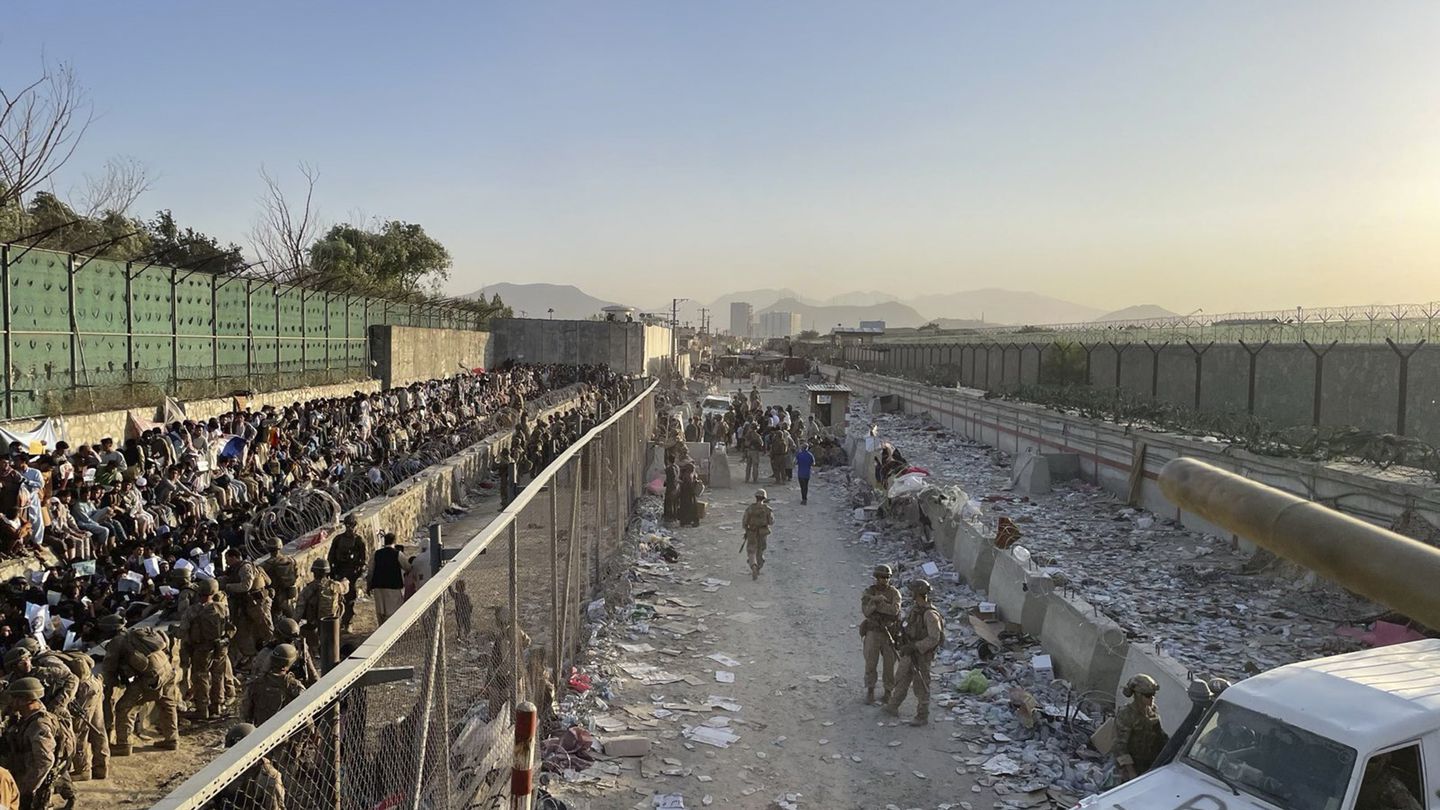
Review says Abbey Gate bombing wasn’t preventable
A new review says the suicide bombing at the Kabul airport that killed U.S. troops and Afghans in August 2021 was not preventable.
WASHINGTON (AP) — The suicide bombing at the Kabul airport that killed U.S. troops and Afghans in August 2021 was not preventable, and the “bald man in black” spotted by U.S. service members the morning of the attack was not the bomber, according to a new review by U.S. Central Command.
The findings. released Monday, refute assertions by some service members who believed they had a chance to take out the would-be bomber but did not get approval. And, for the first time, the U.S. military is confirming that the bomber was Abdul Rahman al-Logari, an Islamic State militant who had been in an Afghan prison but was released by the Taliban as the group took control of the country that summer.
The Abbey Gate bombing during the final chaotic days of the Afghanistan withdrawal killed 13 U.S. service members and 170 Afghans, and wounded scores more. It triggered widespread debate and congressional criticism, fueled by emotional testimony from a Marine injured in the blast, who said snipers believe they saw the possible bomber but couldn’t get approval to take him out.
Former Marine Sgt. Tyler Vargas-Andrews told the House Foreign Affairs Committee last March that Marines and others aiding in the evacuation were given descriptions of men believed to be plotting an attack. Vargas-Andrews, who was injured in the blast but not interviewed in the initial investigation, said he and others saw a man matching the description and might have been able to stop the attack, but requests to take action were denied.
In a detailed briefing to a small number of reporters, members of the team that did the review released photos of the bald man identified by military snipers as a potential threat and compared it with photos of al-Logari. The team members, who spoke to reporters on condition of anonymity to provide details not yet made public, described facial recognition and other analysis they used that they said confirmed those were not the same man.
“For the past two years, some service members have claimed that they had the bomber in their sights and they could have prevented the attack. We now know that is not correct,” said a team member.
They said they also showed the photo of the bald man to service members during the latest interviews, and that the troops again confirmed that was the suspicious man they had targeted.
The review notes that the bald man was first seen around 7 a.m. and that troops lost sight of him by 10 a.m. The bombing was more than seven hours later, and the U.S. says al-Logari didn’t get to Abbey Gate until “very shortly” before the blast took place. They declined to be more specific about the timing, saying details are classified.
Family members of those killed in the blast received similar briefings over the past two weekends and some are still unconvinced.
“For me, personally, we are still not clear. I believe Tyler saw what Tyler saw and he knows what he saw. And it was not the guy that they were claiming was the man in black,” Jim McCollum, the father of Marine Lance Cpl. Rylee McCollum, told The Associated Press.
He said the team went into “pretty good detail, not trying to discredit Tyler, but effectively saying he was wrong. However, that ended up being as clear as mud to us.”
And Mark Schmitz, the father of Marine Lance Cpl. Jared Schmitz, questioned the photo itself.
“They kept saying this is who Tyler Vargas-Andrews was looking at and we were thinking to ourselves, ‘well, that’s interesting. Why is this a picture of a picture from a Canon camera?’” he said. “To me it felt like they were trying to find the guy in those cameras that may have come close to looking like somebody of interest that they can try to sell to us.”
The families, however, also said they were relieved to get more details about their loved ones’ deaths, saying the initial briefings were not as good.
Schmitz said that Army Gen. Eric Kurilla, head of U.S. Central Command, was part of the latest briefing and apologized for how the families were treated during the initial probe. This time around officials were able to share with Schmitz for the first time exactly where his son was when the bomb went off and that he was unconscious almost immediately, and therefore did not feel the impact of the shrapnel that went through his left torso, hitting a primary artery.
“That to me was, first and foremost, the best news I could have gotten,” Schmitz said. “That gave me a little bit of closure that my son didn’t suffer, which made me feel really good.”
Team members said they also are planning to speak with the troops who were interviewed this time, to share the results of the report.
They said the review also could not completely rule out claims that militants did a test run of the bombing several days earlier. But after reviewing photos and other intelligence, the team concluded it was unlikely that three men seen carrying a large bag — which troops deemed suspicious — were doing a trial run.
More broadly, the team said the review brought some new details to light, including more discussion about the possible bombing test run. But they said overall it confirmed the findings of U.S. Central Command’s initial investigation into the bombing: that it was not preventable and that reports of threats prior to the bombing were too vague.
As an example, the new review noted that threat reports talked about a possible bomber with groomed hair, wearing loose clothes, and carrying a black bag. That description, the review said, could have matched anyone in the enormous crowd desperately trying to get into the airport.
The team said they conducted 52 interviews for the review — adding up to a total of 190 when the previous investigation is included. Service members were asked about 64 questions, and the sessions lasted between one hour and seven hours long.
A number of those questioned weren’t included in the original investigation, many because they were severely wounded in the attack. The new review was ordered last September by Kurilla, largely due to criticism of the initial investigation and assertions that the deadly assault could have been stopped.
Members of the team said the Islamic State group put out the bomber’s name on social media, but U.S. intelligence was later able to independently confirm that report.
U.S. Central Command’s initial investigation concluded in November 2021 that given the worsening security situation at the airport’s Abbey Gate as Afghans became increasingly desperate to flee, " the attack was not preventable at the tactical level without degrading the mission to maximize the number of evacuees.”
Critics have slammed the Biden administration for the catastrophic evacuation, and they’ve complained that no one was held accountable for it. And while the U.S. was able to get more than 130,000 civilians out of the country during the panic after the Taliban took control of the government, there were horrifying images of desperate Afghans clinging to military aircraft as they lifted off.
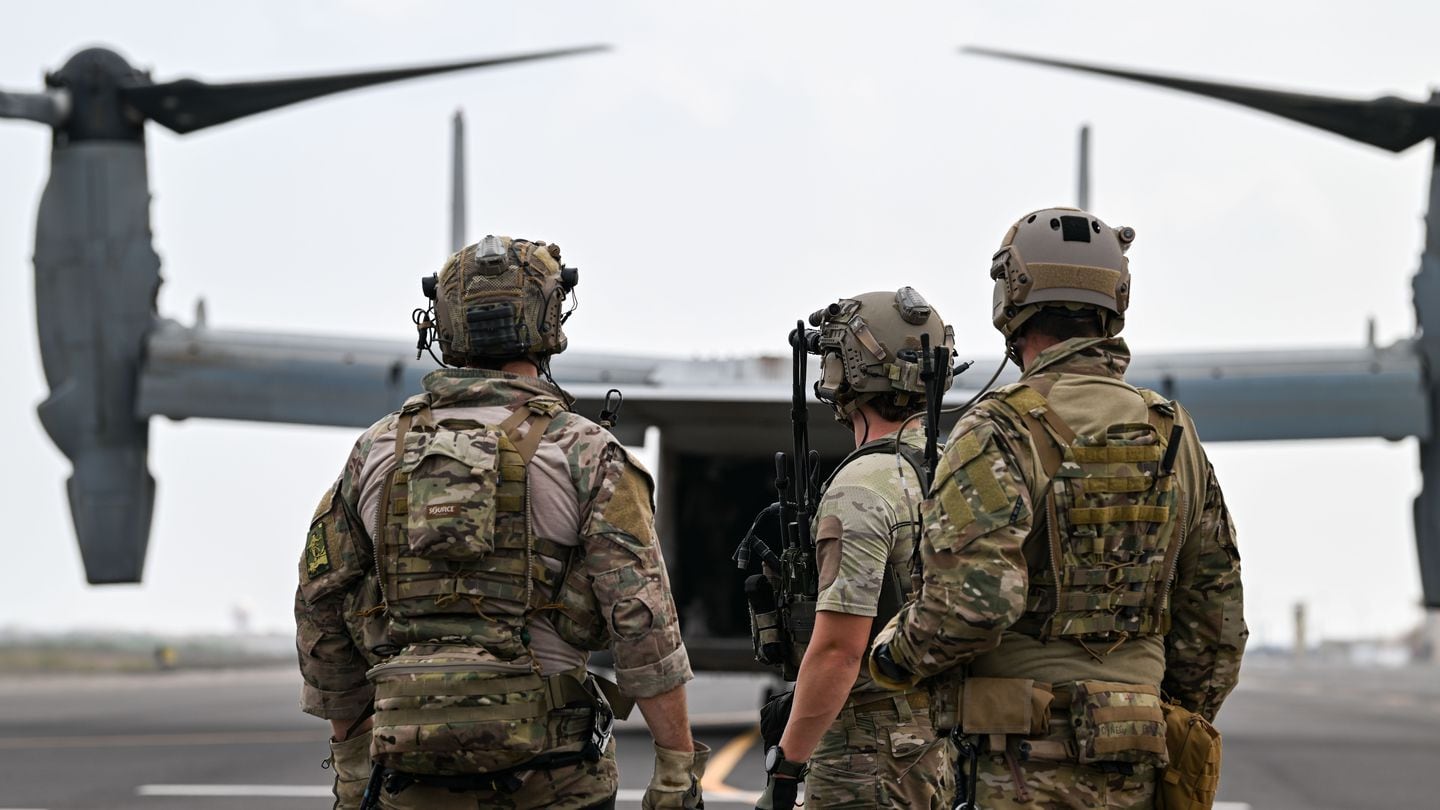
Are you part of the Osprey community? We want to hear from you
Help Military Times understand what it’s like to be part of the Osprey community.
The V-22 Osprey and its crews have played a crucial role in military operations around the world. But as the Osprey continues to rack up deadly accidents, the stories of the people who continue to fly aboard them and keep them running each day have gone untold.
Help Military Times understand what it’s like to be part of the Osprey community: If you have served on an Osprey aircrew, as a maintainer or in another role in the Osprey enterprise, whether in the Air Force, Navy or Marine Corps, please email Air Force Times Editor Rachel Cohen at [email protected] to share your perspective.
Anonymity can be granted upon request if we use any of your insights in future stories.
Thanks for your help, and for your service.

Biden to host Iraq’s leader as Mideast tensions soar
President Joe Biden is set to host Iraq's leader as tensions across the Middle East soar over the war in Gaza and Iran's retaliatory attack on Israel.
WASHINGTON (AP) — President Joe Biden is set to host Iraq’s leader this week for talks that come as tensions across the Middle East have soared over the war in Gaza and Iran’s unprecedented weekend attack on Israel in retaliation for an Israeli military strike against an Iranian facility in Syria.
The sharp rise in security fears has raised further questions about the viability of the two-decade American military presence in Iraq, through which portions of Iran’s Saturday drone and missile attack on Israel flew or were launched from. A U.S. Patriot battery in Irbil, Iraq, knocked down at least one Iranian ballistic missile, according to American officials.
In addition, Iranian proxies have initiated attacks against U.S. interests throughout the region from inside Iraq, making Monday’s meeting between Biden and Iraqi Prime Minister Shia al-Sudani all the more critical. The talks will include a discussion of regional stability and future U.S. troop deployments but will also focus on economic, trade and energy issues that have become a major priority for Iraq’s government, according to U.S. officials.

Biden and Defense Secretary Lloyd Austin are both expected to address the U.S. troop presence in meetings with al-Sudani. “It is not the primary focus of the visit … but it is almost certainly going to come up,” one senior U.S. official said last week.
The U.S. and Iraq began formal talks in January about ending the coalition created to help the Iraqi government fight the Islamic State, with some 2,000 U.S. troops remaining in the country under an agreement with Baghdad. Iraqi officials have periodically called for a withdrawal of those forces.
The two countries have a delicate relationship due in part to Iran’s considerable sway in Iraq, where a coalition of Iran-backed groups brought al-Sudani to power in October 2022.
The U.S. in recent months has urged Iraq to do more to prevent attacks on U.S. bases in Iraq and Syria that have further roiled the Middle East in the aftermath of Hamas’ Oct. 7 attack on Israel. Iran’s weekend attacks on Israel through Iraqi airspace have further underscored U.S. concerns, although al-Sudani had already left Baghdad and was en route to Washington when the drones and missiles were launched.
The U.S. has also sought to apply financial pressure over Baghdad’s relationship with Tehran, restricting Iraq’s access to its own dollars in an effort to stamp out money laundering said to benefit Iran and Syria.
Most previous Iraqi prime ministers have visited Washington earlier in their tenure. Al-Sudani’s visit was delayed because of tensions between the U.S. and Iran and regional escalation, including the Gaza war and the killing of three U.S. soldiers in Jordan in a drone attack in late January. That was followed by a U.S. strike that killed a leader in the Kataib Hezbollah militia whom Washington accused of planning and participating in attacks on U.S. troops.
Al-Sudani came to power in late 2022 after a power struggle between prominent Shiite cleric and political leader Muqtada Sadr and opposing Shiite factions that are close to Iran after the 2021 elections. Sadr ultimately withdrew from the political process, giving the opportunity to the remaining Shia politicians to form a government headed by al-Sudani.
Since then, al-Sudani has attempted to maintain a balancing act between Iran and America despite being seen as being close to Tehran and despite several incidents that have put his government in an embarrassing position in relation to Washington.
Early in al-Sudani’s term, a U.S. citizen, Stephen Edward Troell, was shot and killed by armed men who accosted him as he pulled up to the street where he lived in Baghdad’s central Karrada district with his family. An Iraqi criminal court convicted five men last August and sentenced them to life in prison in the case, which officials described as a kidnapping gone wrong.
A few months later, Elizabeth Tsurkov, an Israeli-Russian doctoral student at Princeton, was kidnapped while doing research in Iraq. Al-Sudani’s visit will come about a year after Tsurkov’s abduction. She is believed to be held by Kataib Hezbollah.
The senior U.S. official said Tsurkov’s case would also be raised.
“We are concerned by and closely tracking this case,” the official said. “We have strongly condemned her abduction. We’ve urged ... and continue to urge senior Iraqi officials to find Elizabeth and to secure her release as soon as possible.”
Al-Sudani started his term with promises to focus on economic development and fight corruption, but his government has faced economic difficulties, including a discrepancy in the official and market exchange rates between the Iraqi dinar and the U.S. dollar.
The currency issues came in part as a result of a U.S. tightening of the dollar supply to Iraq, as part of a crackdown on money laundering and smuggling of funds to Iran. The U.S. has disallowed more than 20 Iraqi banks from dealing in dollars as part of the campaign.
The al-Sudani government recently renewed Iraq’s contract to purchase natural gas from Iran for another five years, which could lead to American displeasure.
The Iraqi prime minister will return to Iraq and meet with the Turkish president following his trip to Washington, which could finally lead to a solution to a long-running dispute over exports of oil from Kurdish areas of Iraq to Turkey. Washington has sought to get the flow of oil to resume.
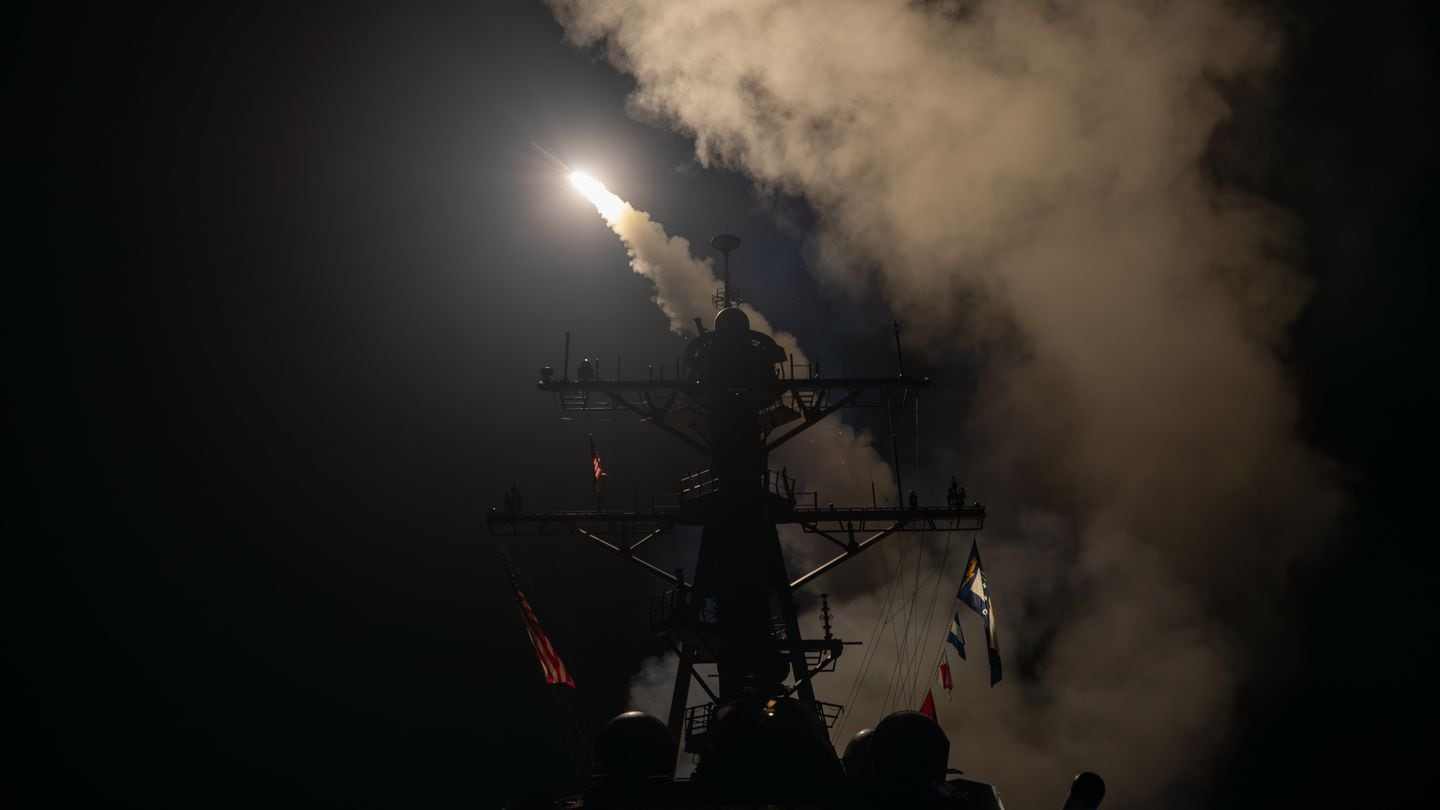
US forces help Israel repel Iranian drone, missile attack
Saturday's attack was Iran's first-ever direct assault on Israel.
The U.S. military shot down dozens of missiles and drones Saturday that were fired at Israel from Iran and its proxy forces in Iraq, Syria and Yemen.
Iran launched its first-ever direct assault on Israel Saturday, less than two weeks after a suspected Israeli strike in Syria killed two Iranian generals in an Iranian consular building.
An Israeli military spokesman said Sunday that Iran and its proxies had fired more than 300 ballistic missiles, drones and cruise missiles at Israel, but that 99 percent of them were intercepted.
“At my direction, to support the defense of Israel, the U.S. military moved aircraft and ballistic missile defense destroyers to the region over the course of the past week,” President Joe Biden said in a statement late Saturday. “Thanks to these deployments and the extraordinary skill of our servicemembers, we helped Israel take down nearly all of the incoming drones and missiles.”
Defense Secretary Lloyd Austin in a statement said the U.S. took out dozens of the attacks but did not provide details on ships or aircraft involved in the operation that commanders had been preparing for over the past two weeks.
“We condemn these reckless and unprecedented attacks by Iran and its proxies, and we call on Iran to immediately halt any further attacks, including from its proxy forces, and to deescalate tensions,” Austin said. “We do not seek conflict with Iran, but we will not hesitate to act to protect our forces and support the defense of Israel.”
With regional tensions at their highest since the Israel-Hamas war began six months ago, Biden pledged on Saturday that American support for Israel’s defense against attacks by Iran and its proxies is “ironclad.” The attack marked the first time Iran has launched a direct military assault on Israel, risking a wider regional conflict.
Biden made clear in a call to Israeli Prime Minister Benjamin Netanyahu that the U.S. would not participate in any offensive action against Iran, according to a senior administration official who was not authorized to publicly discuss the private conversation and spoke on condition of anonymity.
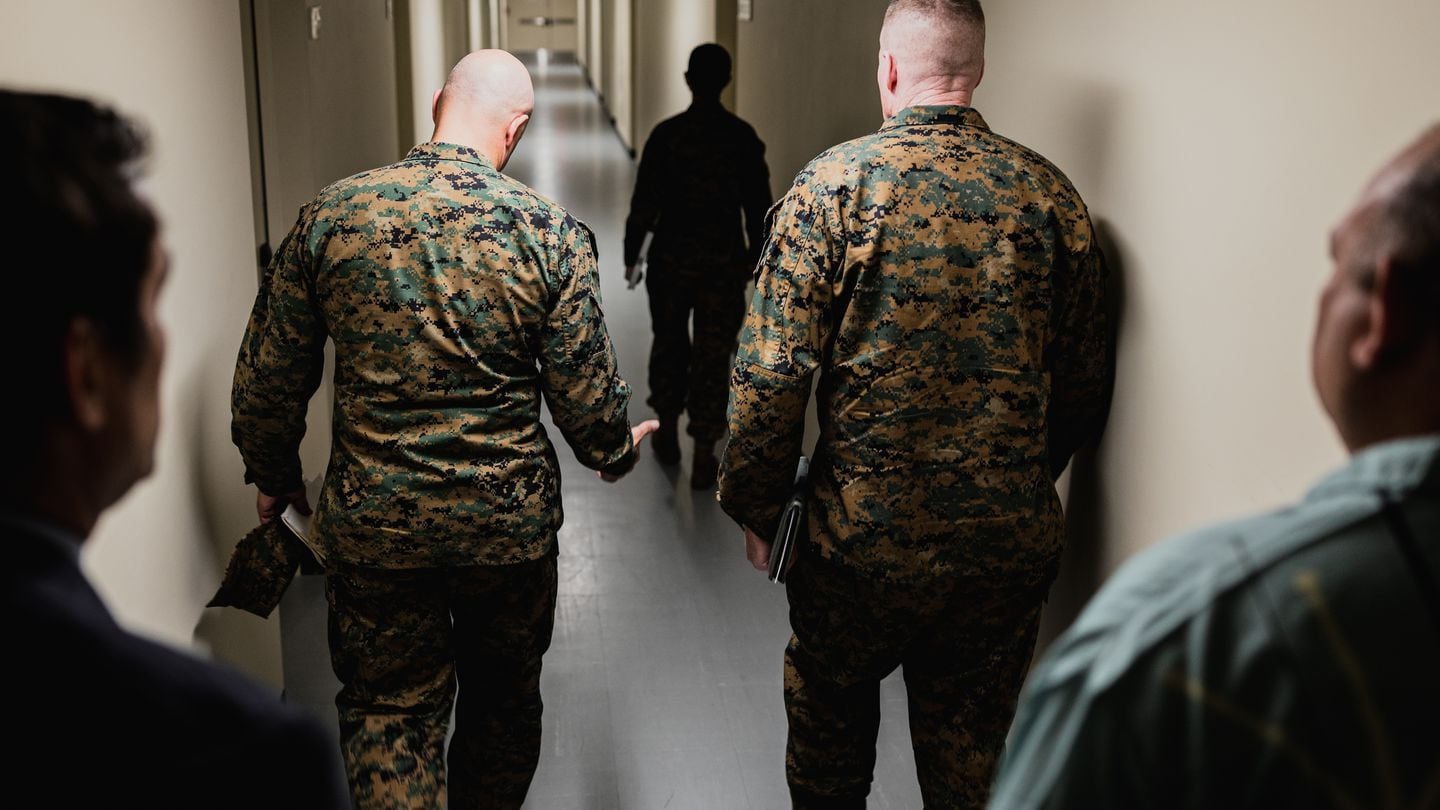
Marines’ plans for barracks fixes, construction scrutinized by Congress
About 83% of the Marine Corps' barracks buildings are in “pretty good shape” and 17% are not.
Some members of Congress were critical of the low level or lack of new construction for barracks and family housing for Marines in a hearing Thursday, citing maintenance backlogs and quality of life issues among the troops.
“I am extremely disappointed to say the least in the lack of quality-of-life projects in the budget request this year,” Rep. Debbie Wasserman Schultz, D-Florida, said in a House appropriations subcommittee hearing. “Is there no need for new construction in these high priority areas?”
Wasserman Schultz cited a September 2023 Government Accountability Office report that showed widespread housing problems across the military services including mold, dysfunctional plumbing, no heating in the winter nor air conditioning in the summer.
The Marines have tackled some of those issues and others in the past year and in their pending budget request for fiscal year 2025 ― just not yet with new construction projects.
Marine Corps vows to inspect every single barracks 'wall to wall'
Lt. Gen. Edward Banta, deputy commandant for installations and logistics, alongside Meredith Berger, assistant secretary of the Navy for installations, energy and environment, laid out the Corps’ plan.
That plan has involved the Corps long-term Barracks 2030 initiative, which saw a 100% wall-to-wall barracks inspection recently conclude. Banta said that the Corps is awaiting the results of that survey to better understand the state of the 658 barracks buildings the Marine Corps has in its inventory.
An estimated 87,000 Marines live in barracks.
Broadly, Banta said, about 83% of those buildings are in “pretty good shape” and 17% are not.
The Corps has requested $274 million in the current budget to fix facility problems. It has added another $65 million to its “unfunded priorities list,” which services use to draw congressional attention to items that could use more funding but didn’t make the cut.
But even the total amount pales compared with what the service needs to bring barracks up to “good/fair” condition.
Rep. Sanford Bishop Jr., D-Georgia, noted that the Corps has a $15.8 billion maintenance backlog and will require $1.5 billion annually for barracks maintenance concerns.
“This reveals a significant budget gap,” Bishop said.
Banta acknowledged the disparity and said the Corps is prioritizing restoration and modernization as it determines which barracks to maintain and which to demolish. The service has requested $61 million for planning and design for future barracks and other military construction.
Separately, Sergeant Major of the Marine Corps Carlos Ruiz addressed housing concerns in remarks Monday at the Navy League’s Sea-Air-Space conference near Washington.
Ruiz noted that in previous years the Corps has opted to spend its money on new weapons and platforms instead of infrastructure needs.
That’s changed.
“We’re transparent with that: Decisions were made not to invest in your buildings because we needed to buy these platforms in order for you to come home, in order for you to win,” Ruiz said at the conference. “But now it’s the time to do both. And it’s OK to ask for both.”
In written remarks and comments at a House hearing Wednesday on the total Navy and Marine Corps budget, Commandant Gen. Eric Smith outlined some of what’s been done so far with housing.
The Corps looks to implement civilian management of its military housing by October, which would put civilian managers over each of the barracks buildings in the next two years.
That would return more than 500 Marine noncommissioned officers currently serving as barracks managers to their primary military jobs, Smith wrote.
The service has averaged more than $200 million spent annually in barracks restoration and modernization in recent years, Smith wrote. It renovated 30 barracks buildings in fiscal years 2022 and 2023 and requested funding for renovations on 13 more buildings in fiscal 2024.